Inclusive Practice: Purpose, Benefits, and Impact on Learning
VerifiedAdded on 2023/01/06
|21
|7112
|61
AI Summary
This document discusses the concept of inclusive practice in education and training, focusing on its purpose, benefits, and impact on learning. It explores the social and cultural factors that affect learning, as well as the impact of cognitive, physical, and sensory abilities. The document also reviews the policies and legislative frameworks that influence inclusive practices in primary schools.
Contribute Materials
Your contribution can guide someone’s learning journey. Share your
documents today.
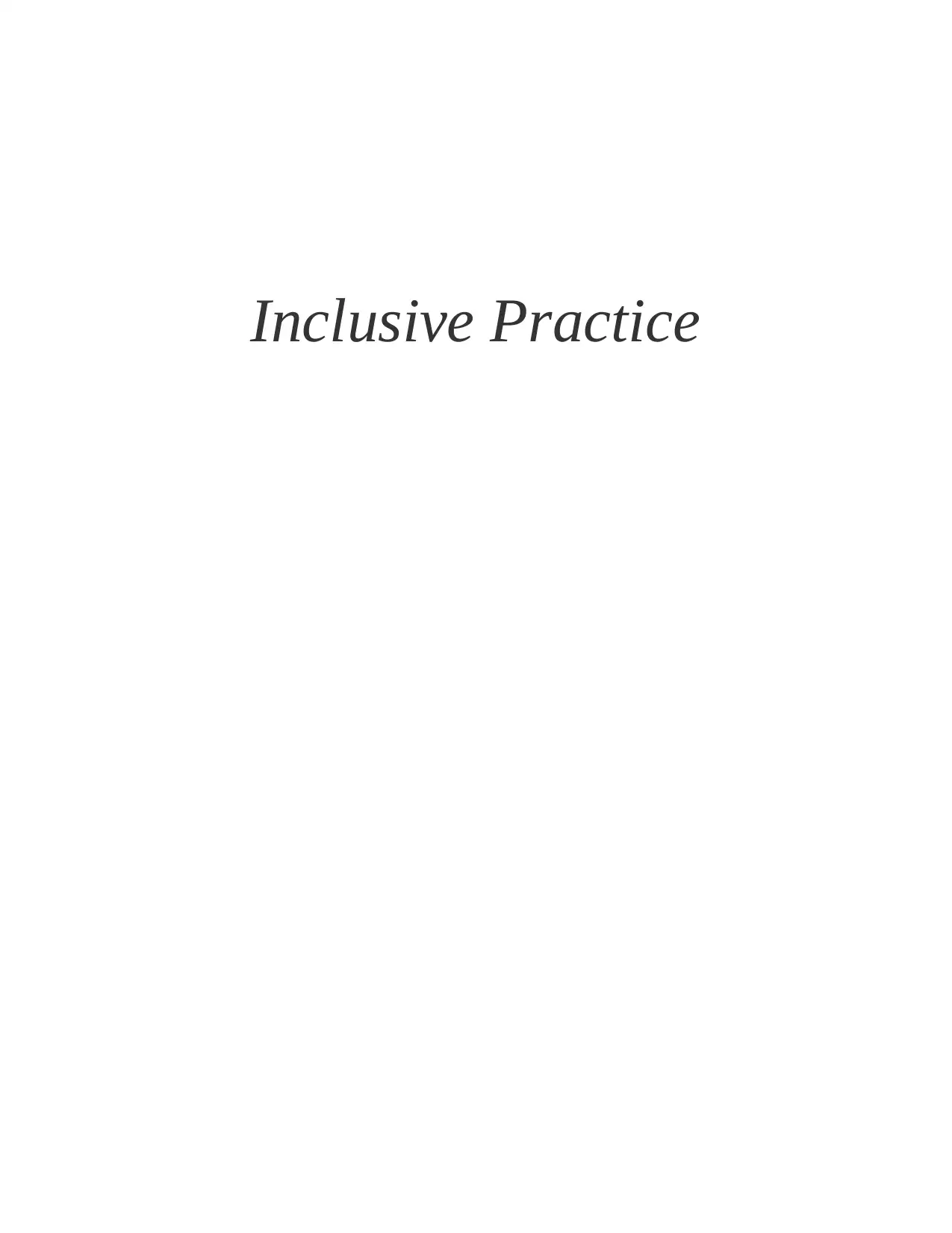
Inclusive Practice
Secure Best Marks with AI Grader
Need help grading? Try our AI Grader for instant feedback on your assignments.
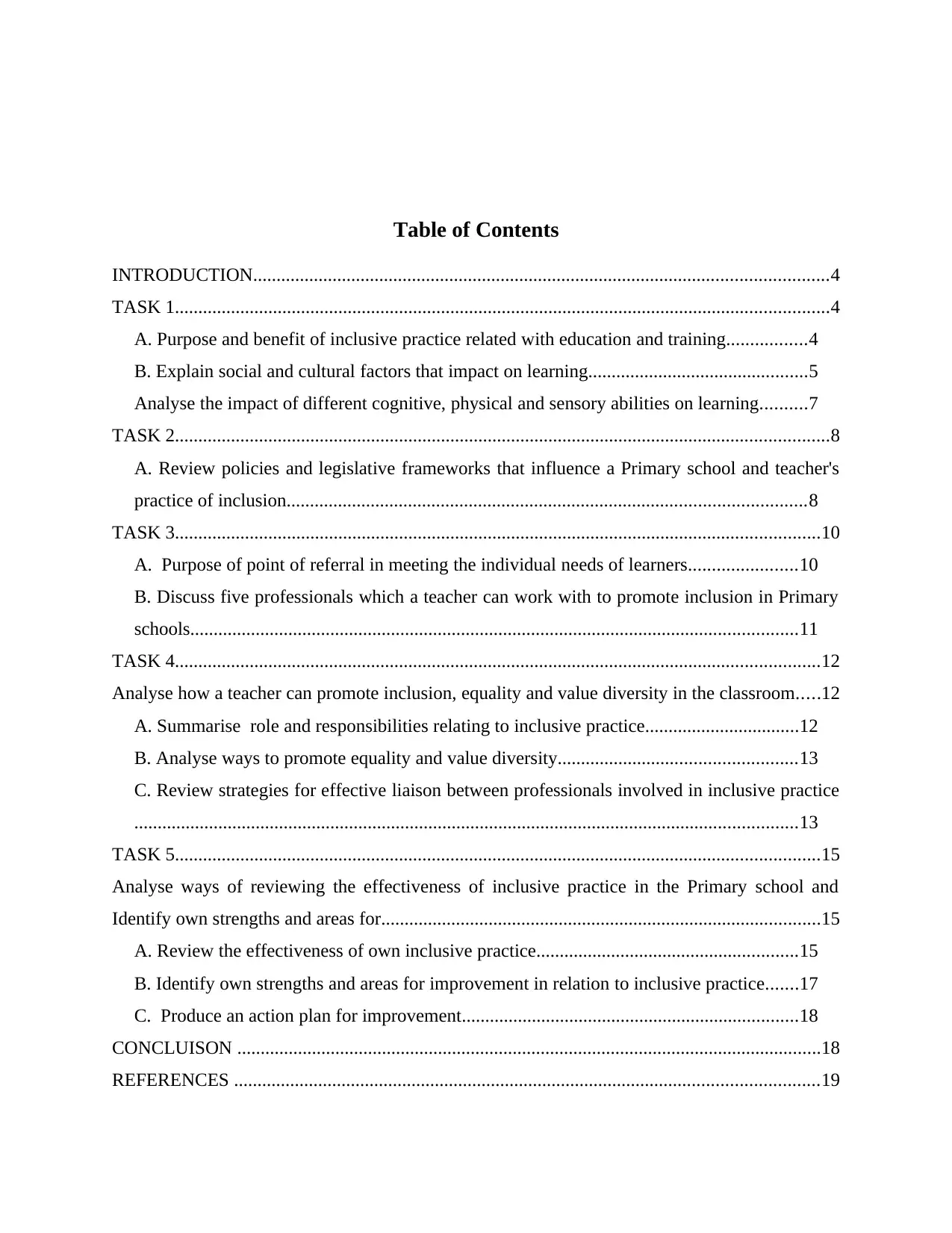
Table of Contents
INTRODUCTION...........................................................................................................................4
TASK 1............................................................................................................................................4
A. Purpose and benefit of inclusive practice related with education and training.................4
B. Explain social and cultural factors that impact on learning...............................................5
Analyse the impact of different cognitive, physical and sensory abilities on learning..........7
TASK 2............................................................................................................................................8
A. Review policies and legislative frameworks that influence a Primary school and teacher's
practice of inclusion...............................................................................................................8
TASK 3..........................................................................................................................................10
A. Purpose of point of referral in meeting the individual needs of learners.......................10
B. Discuss five professionals which a teacher can work with to promote inclusion in Primary
schools..................................................................................................................................11
TASK 4..........................................................................................................................................12
Analyse how a teacher can promote inclusion, equality and value diversity in the classroom.....12
A. Summarise role and responsibilities relating to inclusive practice.................................12
B. Analyse ways to promote equality and value diversity...................................................13
C. Review strategies for effective liaison between professionals involved in inclusive practice
..............................................................................................................................................13
TASK 5..........................................................................................................................................15
Analyse ways of reviewing the effectiveness of inclusive practice in the Primary school and
Identify own strengths and areas for..............................................................................................15
A. Review the effectiveness of own inclusive practice........................................................15
B. Identify own strengths and areas for improvement in relation to inclusive practice.......17
C. Produce an action plan for improvement........................................................................18
CONCLUISON .............................................................................................................................18
REFERENCES .............................................................................................................................19
INTRODUCTION...........................................................................................................................4
TASK 1............................................................................................................................................4
A. Purpose and benefit of inclusive practice related with education and training.................4
B. Explain social and cultural factors that impact on learning...............................................5
Analyse the impact of different cognitive, physical and sensory abilities on learning..........7
TASK 2............................................................................................................................................8
A. Review policies and legislative frameworks that influence a Primary school and teacher's
practice of inclusion...............................................................................................................8
TASK 3..........................................................................................................................................10
A. Purpose of point of referral in meeting the individual needs of learners.......................10
B. Discuss five professionals which a teacher can work with to promote inclusion in Primary
schools..................................................................................................................................11
TASK 4..........................................................................................................................................12
Analyse how a teacher can promote inclusion, equality and value diversity in the classroom.....12
A. Summarise role and responsibilities relating to inclusive practice.................................12
B. Analyse ways to promote equality and value diversity...................................................13
C. Review strategies for effective liaison between professionals involved in inclusive practice
..............................................................................................................................................13
TASK 5..........................................................................................................................................15
Analyse ways of reviewing the effectiveness of inclusive practice in the Primary school and
Identify own strengths and areas for..............................................................................................15
A. Review the effectiveness of own inclusive practice........................................................15
B. Identify own strengths and areas for improvement in relation to inclusive practice.......17
C. Produce an action plan for improvement........................................................................18
CONCLUISON .............................................................................................................................18
REFERENCES .............................................................................................................................19
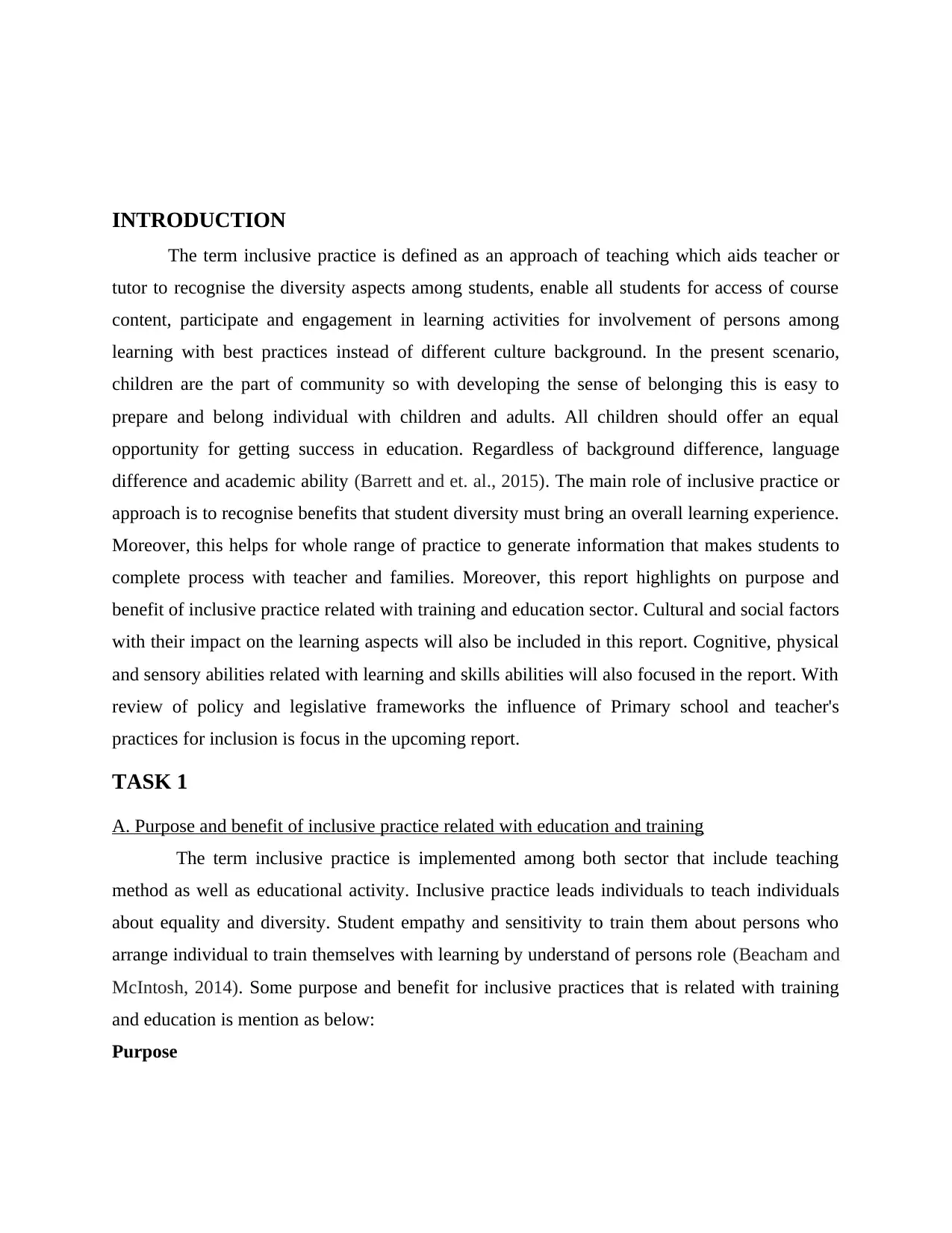
INTRODUCTION
The term inclusive practice is defined as an approach of teaching which aids teacher or
tutor to recognise the diversity aspects among students, enable all students for access of course
content, participate and engagement in learning activities for involvement of persons among
learning with best practices instead of different culture background. In the present scenario,
children are the part of community so with developing the sense of belonging this is easy to
prepare and belong individual with children and adults. All children should offer an equal
opportunity for getting success in education. Regardless of background difference, language
difference and academic ability (Barrett and et. al., 2015). The main role of inclusive practice or
approach is to recognise benefits that student diversity must bring an overall learning experience.
Moreover, this helps for whole range of practice to generate information that makes students to
complete process with teacher and families. Moreover, this report highlights on purpose and
benefit of inclusive practice related with training and education sector. Cultural and social factors
with their impact on the learning aspects will also be included in this report. Cognitive, physical
and sensory abilities related with learning and skills abilities will also focused in the report. With
review of policy and legislative frameworks the influence of Primary school and teacher's
practices for inclusion is focus in the upcoming report.
TASK 1
A. Purpose and benefit of inclusive practice related with education and training
The term inclusive practice is implemented among both sector that include teaching
method as well as educational activity. Inclusive practice leads individuals to teach individuals
about equality and diversity. Student empathy and sensitivity to train them about persons who
arrange individual to train themselves with learning by understand of persons role (Beacham and
McIntosh, 2014). Some purpose and benefit for inclusive practices that is related with training
and education is mention as below:
Purpose
The term inclusive practice is defined as an approach of teaching which aids teacher or
tutor to recognise the diversity aspects among students, enable all students for access of course
content, participate and engagement in learning activities for involvement of persons among
learning with best practices instead of different culture background. In the present scenario,
children are the part of community so with developing the sense of belonging this is easy to
prepare and belong individual with children and adults. All children should offer an equal
opportunity for getting success in education. Regardless of background difference, language
difference and academic ability (Barrett and et. al., 2015). The main role of inclusive practice or
approach is to recognise benefits that student diversity must bring an overall learning experience.
Moreover, this helps for whole range of practice to generate information that makes students to
complete process with teacher and families. Moreover, this report highlights on purpose and
benefit of inclusive practice related with training and education sector. Cultural and social factors
with their impact on the learning aspects will also be included in this report. Cognitive, physical
and sensory abilities related with learning and skills abilities will also focused in the report. With
review of policy and legislative frameworks the influence of Primary school and teacher's
practices for inclusion is focus in the upcoming report.
TASK 1
A. Purpose and benefit of inclusive practice related with education and training
The term inclusive practice is implemented among both sector that include teaching
method as well as educational activity. Inclusive practice leads individuals to teach individuals
about equality and diversity. Student empathy and sensitivity to train them about persons who
arrange individual to train themselves with learning by understand of persons role (Beacham and
McIntosh, 2014). Some purpose and benefit for inclusive practices that is related with training
and education is mention as below:
Purpose
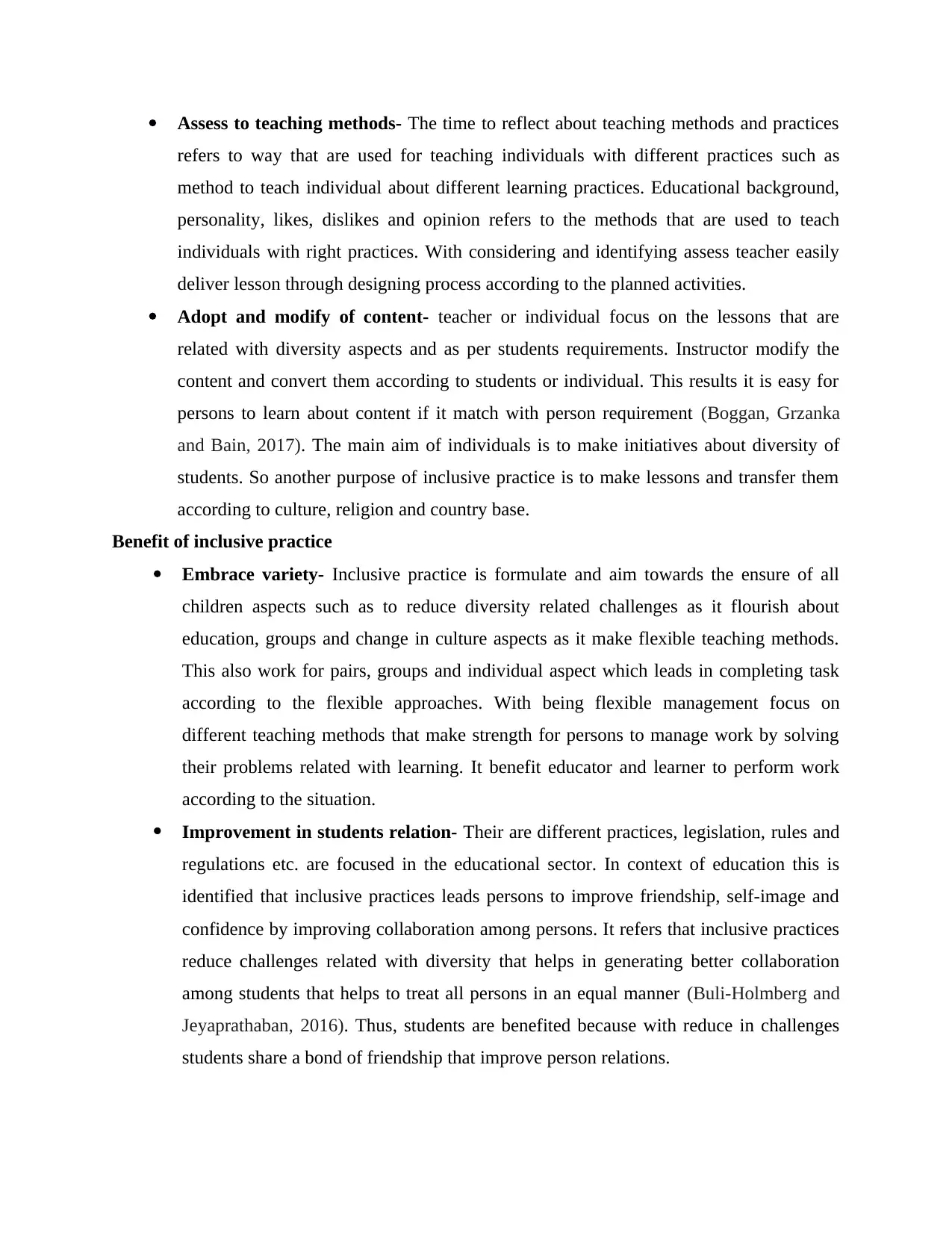
Assess to teaching methods- The time to reflect about teaching methods and practices
refers to way that are used for teaching individuals with different practices such as
method to teach individual about different learning practices. Educational background,
personality, likes, dislikes and opinion refers to the methods that are used to teach
individuals with right practices. With considering and identifying assess teacher easily
deliver lesson through designing process according to the planned activities.
Adopt and modify of content- teacher or individual focus on the lessons that are
related with diversity aspects and as per students requirements. Instructor modify the
content and convert them according to students or individual. This results it is easy for
persons to learn about content if it match with person requirement (Boggan, Grzanka
and Bain, 2017). The main aim of individuals is to make initiatives about diversity of
students. So another purpose of inclusive practice is to make lessons and transfer them
according to culture, religion and country base.
Benefit of inclusive practice
Embrace variety- Inclusive practice is formulate and aim towards the ensure of all
children aspects such as to reduce diversity related challenges as it flourish about
education, groups and change in culture aspects as it make flexible teaching methods.
This also work for pairs, groups and individual aspect which leads in completing task
according to the flexible approaches. With being flexible management focus on
different teaching methods that make strength for persons to manage work by solving
their problems related with learning. It benefit educator and learner to perform work
according to the situation.
Improvement in students relation- Their are different practices, legislation, rules and
regulations etc. are focused in the educational sector. In context of education this is
identified that inclusive practices leads persons to improve friendship, self-image and
confidence by improving collaboration among persons. It refers that inclusive practices
reduce challenges related with diversity that helps in generating better collaboration
among students that helps to treat all persons in an equal manner (Buli-Holmberg and
Jeyaprathaban, 2016). Thus, students are benefited because with reduce in challenges
students share a bond of friendship that improve person relations.
refers to way that are used for teaching individuals with different practices such as
method to teach individual about different learning practices. Educational background,
personality, likes, dislikes and opinion refers to the methods that are used to teach
individuals with right practices. With considering and identifying assess teacher easily
deliver lesson through designing process according to the planned activities.
Adopt and modify of content- teacher or individual focus on the lessons that are
related with diversity aspects and as per students requirements. Instructor modify the
content and convert them according to students or individual. This results it is easy for
persons to learn about content if it match with person requirement (Boggan, Grzanka
and Bain, 2017). The main aim of individuals is to make initiatives about diversity of
students. So another purpose of inclusive practice is to make lessons and transfer them
according to culture, religion and country base.
Benefit of inclusive practice
Embrace variety- Inclusive practice is formulate and aim towards the ensure of all
children aspects such as to reduce diversity related challenges as it flourish about
education, groups and change in culture aspects as it make flexible teaching methods.
This also work for pairs, groups and individual aspect which leads in completing task
according to the flexible approaches. With being flexible management focus on
different teaching methods that make strength for persons to manage work by solving
their problems related with learning. It benefit educator and learner to perform work
according to the situation.
Improvement in students relation- Their are different practices, legislation, rules and
regulations etc. are focused in the educational sector. In context of education this is
identified that inclusive practices leads persons to improve friendship, self-image and
confidence by improving collaboration among persons. It refers that inclusive practices
reduce challenges related with diversity that helps in generating better collaboration
among students that helps to treat all persons in an equal manner (Buli-Holmberg and
Jeyaprathaban, 2016). Thus, students are benefited because with reduce in challenges
students share a bond of friendship that improve person relations.
Secure Best Marks with AI Grader
Need help grading? Try our AI Grader for instant feedback on your assignments.
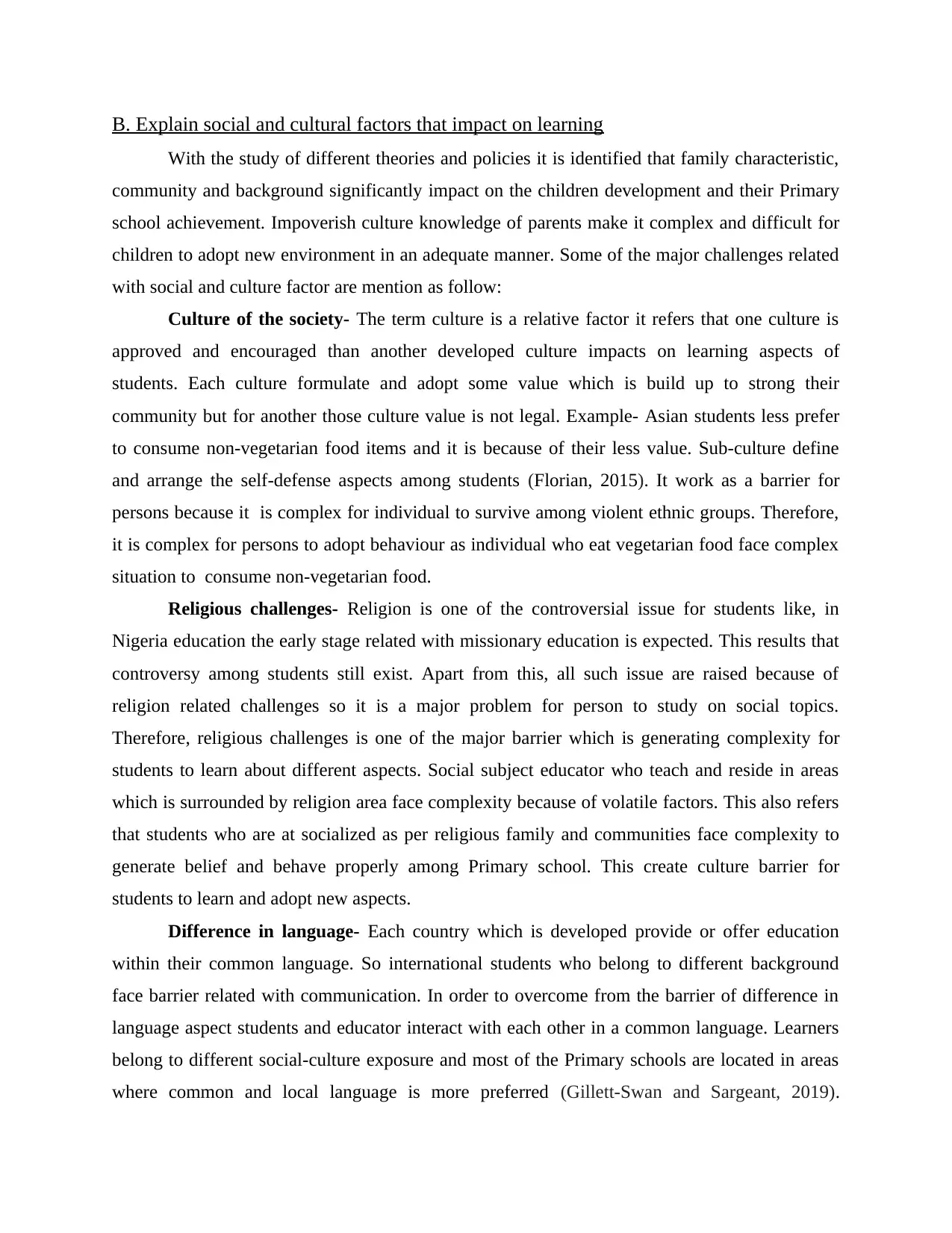
B. Explain social and cultural factors that impact on learning
With the study of different theories and policies it is identified that family characteristic,
community and background significantly impact on the children development and their Primary
school achievement. Impoverish culture knowledge of parents make it complex and difficult for
children to adopt new environment in an adequate manner. Some of the major challenges related
with social and culture factor are mention as follow:
Culture of the society- The term culture is a relative factor it refers that one culture is
approved and encouraged than another developed culture impacts on learning aspects of
students. Each culture formulate and adopt some value which is build up to strong their
community but for another those culture value is not legal. Example- Asian students less prefer
to consume non-vegetarian food items and it is because of their less value. Sub-culture define
and arrange the self-defense aspects among students (Florian, 2015). It work as a barrier for
persons because it is complex for individual to survive among violent ethnic groups. Therefore,
it is complex for persons to adopt behaviour as individual who eat vegetarian food face complex
situation to consume non-vegetarian food.
Religious challenges- Religion is one of the controversial issue for students like, in
Nigeria education the early stage related with missionary education is expected. This results that
controversy among students still exist. Apart from this, all such issue are raised because of
religion related challenges so it is a major problem for person to study on social topics.
Therefore, religious challenges is one of the major barrier which is generating complexity for
students to learn about different aspects. Social subject educator who teach and reside in areas
which is surrounded by religion area face complexity because of volatile factors. This also refers
that students who are at socialized as per religious family and communities face complexity to
generate belief and behave properly among Primary school. This create culture barrier for
students to learn and adopt new aspects.
Difference in language- Each country which is developed provide or offer education
within their common language. So international students who belong to different background
face barrier related with communication. In order to overcome from the barrier of difference in
language aspect students and educator interact with each other in a common language. Learners
belong to different social-culture exposure and most of the Primary schools are located in areas
where common and local language is more preferred (Gillett-Swan and Sargeant, 2019).
With the study of different theories and policies it is identified that family characteristic,
community and background significantly impact on the children development and their Primary
school achievement. Impoverish culture knowledge of parents make it complex and difficult for
children to adopt new environment in an adequate manner. Some of the major challenges related
with social and culture factor are mention as follow:
Culture of the society- The term culture is a relative factor it refers that one culture is
approved and encouraged than another developed culture impacts on learning aspects of
students. Each culture formulate and adopt some value which is build up to strong their
community but for another those culture value is not legal. Example- Asian students less prefer
to consume non-vegetarian food items and it is because of their less value. Sub-culture define
and arrange the self-defense aspects among students (Florian, 2015). It work as a barrier for
persons because it is complex for individual to survive among violent ethnic groups. Therefore,
it is complex for persons to adopt behaviour as individual who eat vegetarian food face complex
situation to consume non-vegetarian food.
Religious challenges- Religion is one of the controversial issue for students like, in
Nigeria education the early stage related with missionary education is expected. This results that
controversy among students still exist. Apart from this, all such issue are raised because of
religion related challenges so it is a major problem for person to study on social topics.
Therefore, religious challenges is one of the major barrier which is generating complexity for
students to learn about different aspects. Social subject educator who teach and reside in areas
which is surrounded by religion area face complexity because of volatile factors. This also refers
that students who are at socialized as per religious family and communities face complexity to
generate belief and behave properly among Primary school. This create culture barrier for
students to learn and adopt new aspects.
Difference in language- Each country which is developed provide or offer education
within their common language. So international students who belong to different background
face barrier related with communication. In order to overcome from the barrier of difference in
language aspect students and educator interact with each other in a common language. Learners
belong to different social-culture exposure and most of the Primary schools are located in areas
where common and local language is more preferred (Gillett-Swan and Sargeant, 2019).
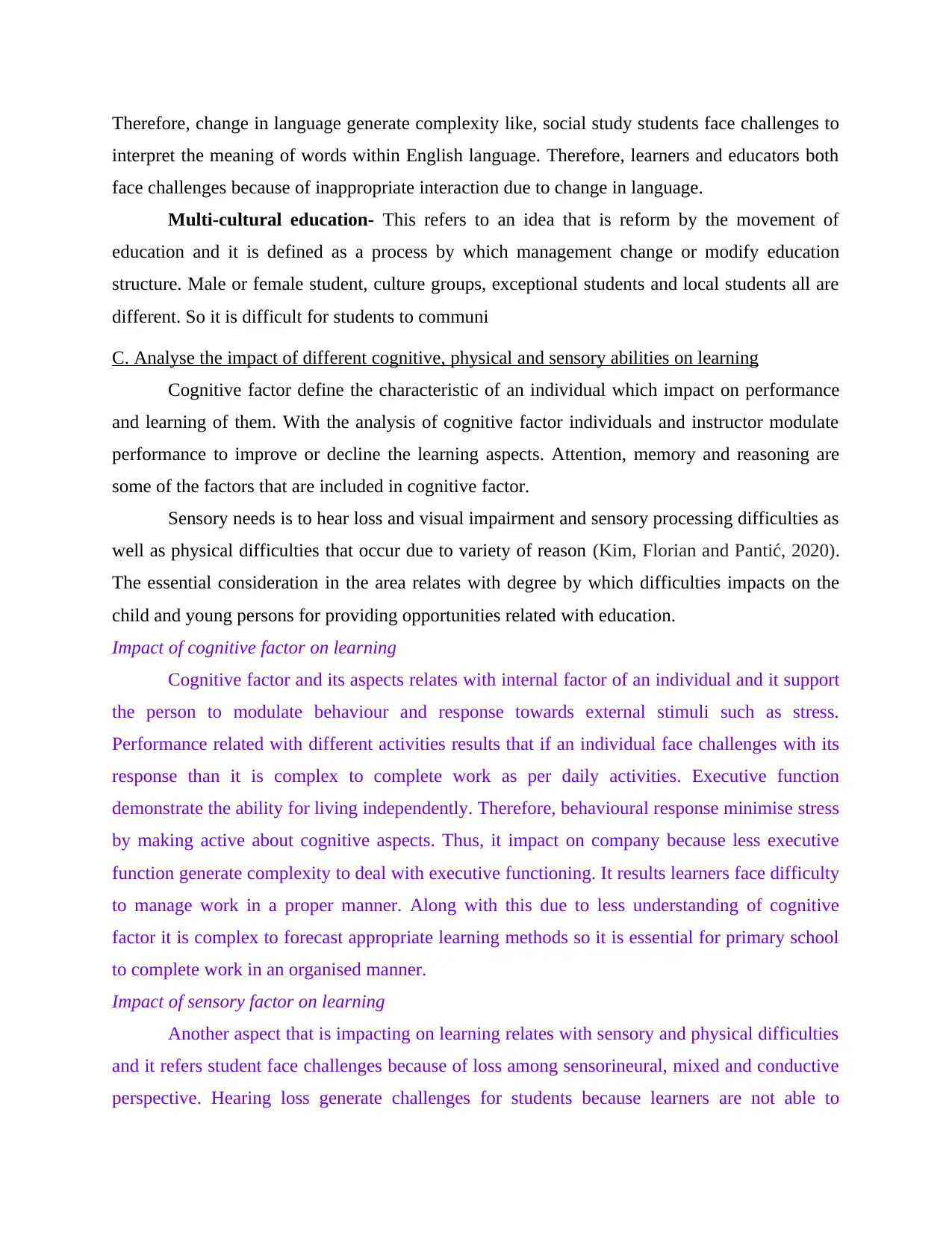
Therefore, change in language generate complexity like, social study students face challenges to
interpret the meaning of words within English language. Therefore, learners and educators both
face challenges because of inappropriate interaction due to change in language.
Multi-cultural education- This refers to an idea that is reform by the movement of
education and it is defined as a process by which management change or modify education
structure. Male or female student, culture groups, exceptional students and local students all are
different. So it is difficult for students to communi
C. Analyse the impact of different cognitive, physical and sensory abilities on learning
Cognitive factor define the characteristic of an individual which impact on performance
and learning of them. With the analysis of cognitive factor individuals and instructor modulate
performance to improve or decline the learning aspects. Attention, memory and reasoning are
some of the factors that are included in cognitive factor.
Sensory needs is to hear loss and visual impairment and sensory processing difficulties as
well as physical difficulties that occur due to variety of reason (Kim, Florian and Pantić, 2020).
The essential consideration in the area relates with degree by which difficulties impacts on the
child and young persons for providing opportunities related with education.
Impact of cognitive factor on learning
Cognitive factor and its aspects relates with internal factor of an individual and it support
the person to modulate behaviour and response towards external stimuli such as stress.
Performance related with different activities results that if an individual face challenges with its
response than it is complex to complete work as per daily activities. Executive function
demonstrate the ability for living independently. Therefore, behavioural response minimise stress
by making active about cognitive aspects. Thus, it impact on company because less executive
function generate complexity to deal with executive functioning. It results learners face difficulty
to manage work in a proper manner. Along with this due to less understanding of cognitive
factor it is complex to forecast appropriate learning methods so it is essential for primary school
to complete work in an organised manner.
Impact of sensory factor on learning
Another aspect that is impacting on learning relates with sensory and physical difficulties
and it refers student face challenges because of loss among sensorineural, mixed and conductive
perspective. Hearing loss generate challenges for students because learners are not able to
interpret the meaning of words within English language. Therefore, learners and educators both
face challenges because of inappropriate interaction due to change in language.
Multi-cultural education- This refers to an idea that is reform by the movement of
education and it is defined as a process by which management change or modify education
structure. Male or female student, culture groups, exceptional students and local students all are
different. So it is difficult for students to communi
C. Analyse the impact of different cognitive, physical and sensory abilities on learning
Cognitive factor define the characteristic of an individual which impact on performance
and learning of them. With the analysis of cognitive factor individuals and instructor modulate
performance to improve or decline the learning aspects. Attention, memory and reasoning are
some of the factors that are included in cognitive factor.
Sensory needs is to hear loss and visual impairment and sensory processing difficulties as
well as physical difficulties that occur due to variety of reason (Kim, Florian and Pantić, 2020).
The essential consideration in the area relates with degree by which difficulties impacts on the
child and young persons for providing opportunities related with education.
Impact of cognitive factor on learning
Cognitive factor and its aspects relates with internal factor of an individual and it support
the person to modulate behaviour and response towards external stimuli such as stress.
Performance related with different activities results that if an individual face challenges with its
response than it is complex to complete work as per daily activities. Executive function
demonstrate the ability for living independently. Therefore, behavioural response minimise stress
by making active about cognitive aspects. Thus, it impact on company because less executive
function generate complexity to deal with executive functioning. It results learners face difficulty
to manage work in a proper manner. Along with this due to less understanding of cognitive
factor it is complex to forecast appropriate learning methods so it is essential for primary school
to complete work in an organised manner.
Impact of sensory factor on learning
Another aspect that is impacting on learning relates with sensory and physical difficulties
and it refers student face challenges because of loss among sensorineural, mixed and conductive
perspective. Hearing loss generate challenges for students because learners are not able to
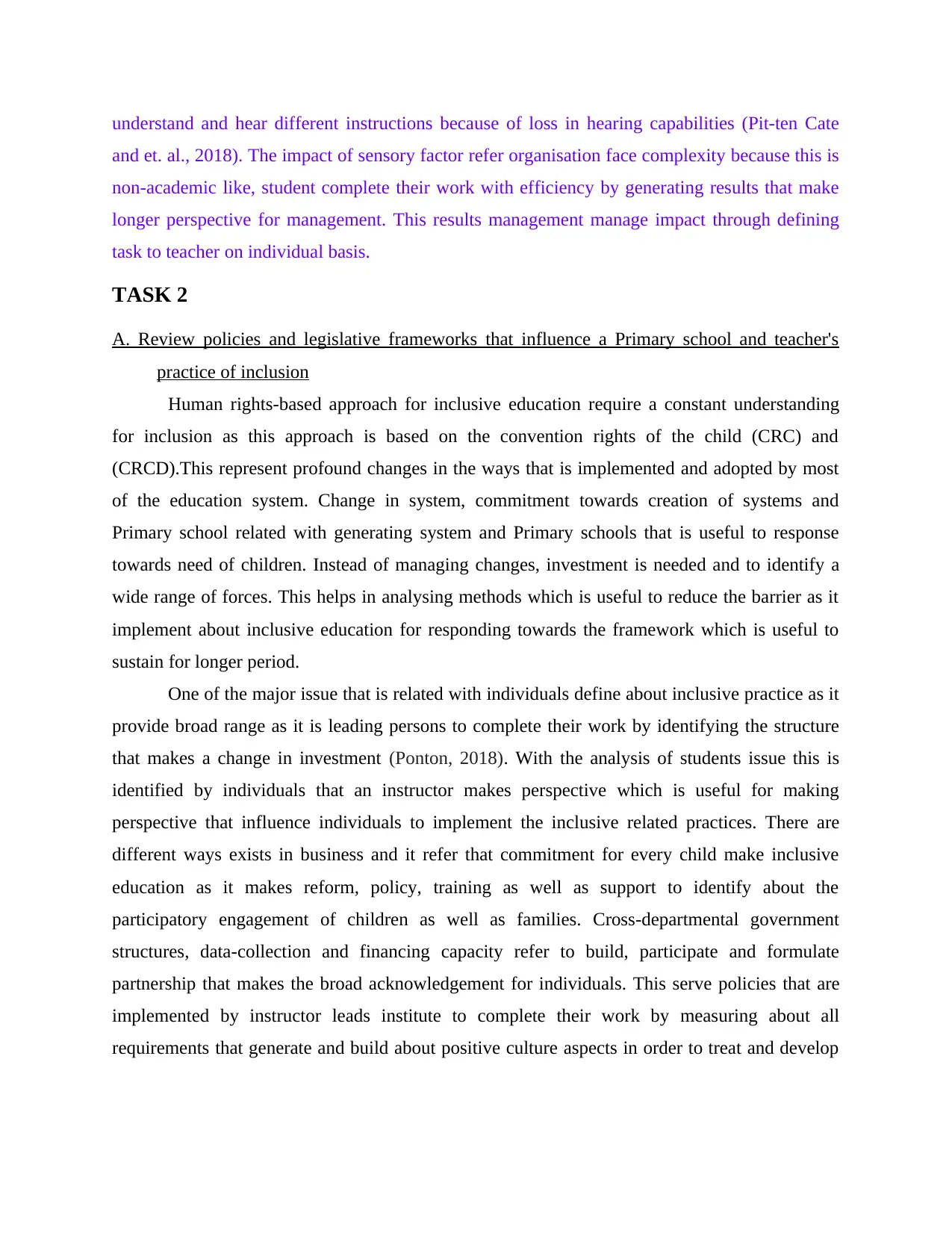
understand and hear different instructions because of loss in hearing capabilities (Pit-ten Cate
and et. al., 2018). The impact of sensory factor refer organisation face complexity because this is
non-academic like, student complete their work with efficiency by generating results that make
longer perspective for management. This results management manage impact through defining
task to teacher on individual basis.
TASK 2
A. Review policies and legislative frameworks that influence a Primary school and teacher's
practice of inclusion
Human rights-based approach for inclusive education require a constant understanding
for inclusion as this approach is based on the convention rights of the child (CRC) and
(CRCD).This represent profound changes in the ways that is implemented and adopted by most
of the education system. Change in system, commitment towards creation of systems and
Primary school related with generating system and Primary schools that is useful to response
towards need of children. Instead of managing changes, investment is needed and to identify a
wide range of forces. This helps in analysing methods which is useful to reduce the barrier as it
implement about inclusive education for responding towards the framework which is useful to
sustain for longer period.
One of the major issue that is related with individuals define about inclusive practice as it
provide broad range as it is leading persons to complete their work by identifying the structure
that makes a change in investment (Ponton, 2018). With the analysis of students issue this is
identified by individuals that an instructor makes perspective which is useful for making
perspective that influence individuals to implement the inclusive related practices. There are
different ways exists in business and it refer that commitment for every child make inclusive
education as it makes reform, policy, training as well as support to identify about the
participatory engagement of children as well as families. Cross-departmental government
structures, data-collection and financing capacity refer to build, participate and formulate
partnership that makes the broad acknowledgement for individuals. This serve policies that are
implemented by instructor leads institute to complete their work by measuring about all
requirements that generate and build about positive culture aspects in order to treat and develop
and et. al., 2018). The impact of sensory factor refer organisation face complexity because this is
non-academic like, student complete their work with efficiency by generating results that make
longer perspective for management. This results management manage impact through defining
task to teacher on individual basis.
TASK 2
A. Review policies and legislative frameworks that influence a Primary school and teacher's
practice of inclusion
Human rights-based approach for inclusive education require a constant understanding
for inclusion as this approach is based on the convention rights of the child (CRC) and
(CRCD).This represent profound changes in the ways that is implemented and adopted by most
of the education system. Change in system, commitment towards creation of systems and
Primary school related with generating system and Primary schools that is useful to response
towards need of children. Instead of managing changes, investment is needed and to identify a
wide range of forces. This helps in analysing methods which is useful to reduce the barrier as it
implement about inclusive education for responding towards the framework which is useful to
sustain for longer period.
One of the major issue that is related with individuals define about inclusive practice as it
provide broad range as it is leading persons to complete their work by identifying the structure
that makes a change in investment (Ponton, 2018). With the analysis of students issue this is
identified by individuals that an instructor makes perspective which is useful for making
perspective that influence individuals to implement the inclusive related practices. There are
different ways exists in business and it refer that commitment for every child make inclusive
education as it makes reform, policy, training as well as support to identify about the
participatory engagement of children as well as families. Cross-departmental government
structures, data-collection and financing capacity refer to build, participate and formulate
partnership that makes the broad acknowledgement for individuals. This serve policies that are
implemented by instructor leads institute to complete their work by measuring about all
requirements that generate and build about positive culture aspects in order to treat and develop
Paraphrase This Document
Need a fresh take? Get an instant paraphrase of this document with our AI Paraphraser
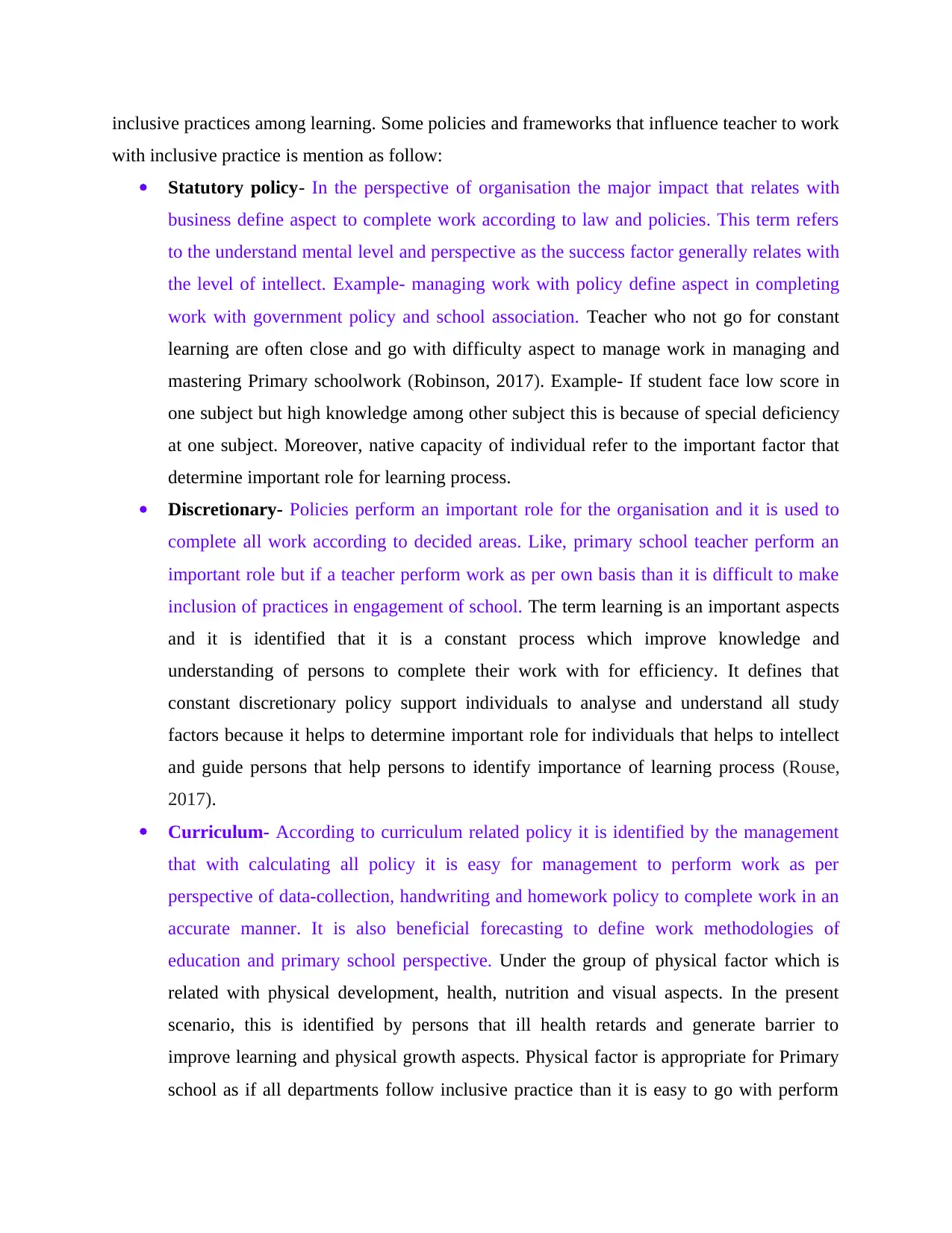
inclusive practices among learning. Some policies and frameworks that influence teacher to work
with inclusive practice is mention as follow:
Statutory policy- In the perspective of organisation the major impact that relates with
business define aspect to complete work according to law and policies. This term refers
to the understand mental level and perspective as the success factor generally relates with
the level of intellect. Example- managing work with policy define aspect in completing
work with government policy and school association. Teacher who not go for constant
learning are often close and go with difficulty aspect to manage work in managing and
mastering Primary schoolwork (Robinson, 2017). Example- If student face low score in
one subject but high knowledge among other subject this is because of special deficiency
at one subject. Moreover, native capacity of individual refer to the important factor that
determine important role for learning process.
Discretionary- Policies perform an important role for the organisation and it is used to
complete all work according to decided areas. Like, primary school teacher perform an
important role but if a teacher perform work as per own basis than it is difficult to make
inclusion of practices in engagement of school. The term learning is an important aspects
and it is identified that it is a constant process which improve knowledge and
understanding of persons to complete their work with for efficiency. It defines that
constant discretionary policy support individuals to analyse and understand all study
factors because it helps to determine important role for individuals that helps to intellect
and guide persons that help persons to identify importance of learning process (Rouse,
2017).
Curriculum- According to curriculum related policy it is identified by the management
that with calculating all policy it is easy for management to perform work as per
perspective of data-collection, handwriting and homework policy to complete work in an
accurate manner. It is also beneficial forecasting to define work methodologies of
education and primary school perspective. Under the group of physical factor which is
related with physical development, health, nutrition and visual aspects. In the present
scenario, this is identified by persons that ill health retards and generate barrier to
improve learning and physical growth aspects. Physical factor is appropriate for Primary
school as if all departments follow inclusive practice than it is easy to go with perform
with inclusive practice is mention as follow:
Statutory policy- In the perspective of organisation the major impact that relates with
business define aspect to complete work according to law and policies. This term refers
to the understand mental level and perspective as the success factor generally relates with
the level of intellect. Example- managing work with policy define aspect in completing
work with government policy and school association. Teacher who not go for constant
learning are often close and go with difficulty aspect to manage work in managing and
mastering Primary schoolwork (Robinson, 2017). Example- If student face low score in
one subject but high knowledge among other subject this is because of special deficiency
at one subject. Moreover, native capacity of individual refer to the important factor that
determine important role for learning process.
Discretionary- Policies perform an important role for the organisation and it is used to
complete all work according to decided areas. Like, primary school teacher perform an
important role but if a teacher perform work as per own basis than it is difficult to make
inclusion of practices in engagement of school. The term learning is an important aspects
and it is identified that it is a constant process which improve knowledge and
understanding of persons to complete their work with for efficiency. It defines that
constant discretionary policy support individuals to analyse and understand all study
factors because it helps to determine important role for individuals that helps to intellect
and guide persons that help persons to identify importance of learning process (Rouse,
2017).
Curriculum- According to curriculum related policy it is identified by the management
that with calculating all policy it is easy for management to perform work as per
perspective of data-collection, handwriting and homework policy to complete work in an
accurate manner. It is also beneficial forecasting to define work methodologies of
education and primary school perspective. Under the group of physical factor which is
related with physical development, health, nutrition and visual aspects. In the present
scenario, this is identified by persons that ill health retards and generate barrier to
improve learning and physical growth aspects. Physical factor is appropriate for Primary
school as if all departments follow inclusive practice than it is easy to go with perform
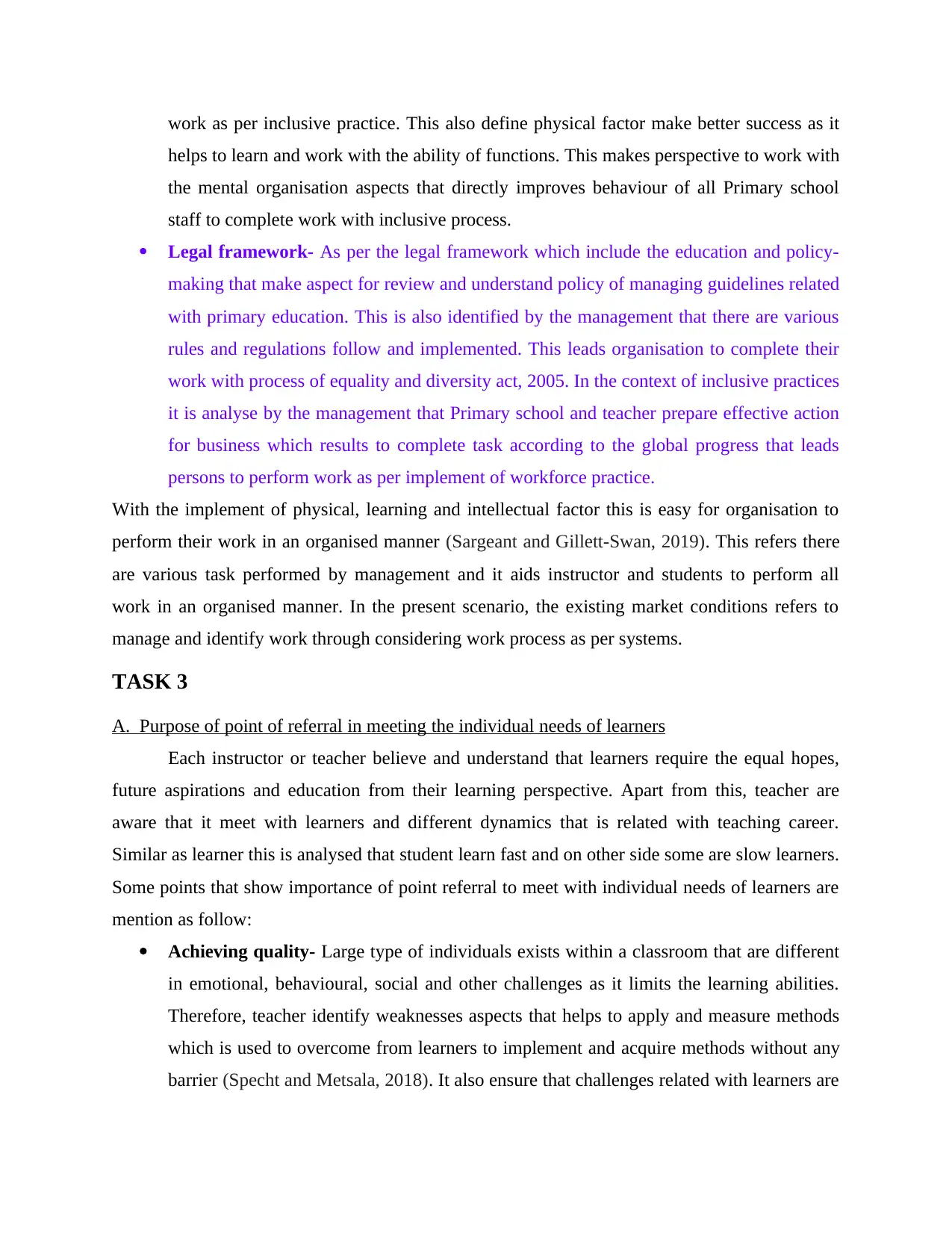
work as per inclusive practice. This also define physical factor make better success as it
helps to learn and work with the ability of functions. This makes perspective to work with
the mental organisation aspects that directly improves behaviour of all Primary school
staff to complete work with inclusive process.
Legal framework- As per the legal framework which include the education and policy-
making that make aspect for review and understand policy of managing guidelines related
with primary education. This is also identified by the management that there are various
rules and regulations follow and implemented. This leads organisation to complete their
work with process of equality and diversity act, 2005. In the context of inclusive practices
it is analyse by the management that Primary school and teacher prepare effective action
for business which results to complete task according to the global progress that leads
persons to perform work as per implement of workforce practice.
With the implement of physical, learning and intellectual factor this is easy for organisation to
perform their work in an organised manner (Sargeant and Gillett-Swan, 2019). This refers there
are various task performed by management and it aids instructor and students to perform all
work in an organised manner. In the present scenario, the existing market conditions refers to
manage and identify work through considering work process as per systems.
TASK 3
A. Purpose of point of referral in meeting the individual needs of learners
Each instructor or teacher believe and understand that learners require the equal hopes,
future aspirations and education from their learning perspective. Apart from this, teacher are
aware that it meet with learners and different dynamics that is related with teaching career.
Similar as learner this is analysed that student learn fast and on other side some are slow learners.
Some points that show importance of point referral to meet with individual needs of learners are
mention as follow:
Achieving quality- Large type of individuals exists within a classroom that are different
in emotional, behavioural, social and other challenges as it limits the learning abilities.
Therefore, teacher identify weaknesses aspects that helps to apply and measure methods
which is used to overcome from learners to implement and acquire methods without any
barrier (Specht and Metsala, 2018). It also ensure that challenges related with learners are
helps to learn and work with the ability of functions. This makes perspective to work with
the mental organisation aspects that directly improves behaviour of all Primary school
staff to complete work with inclusive process.
Legal framework- As per the legal framework which include the education and policy-
making that make aspect for review and understand policy of managing guidelines related
with primary education. This is also identified by the management that there are various
rules and regulations follow and implemented. This leads organisation to complete their
work with process of equality and diversity act, 2005. In the context of inclusive practices
it is analyse by the management that Primary school and teacher prepare effective action
for business which results to complete task according to the global progress that leads
persons to perform work as per implement of workforce practice.
With the implement of physical, learning and intellectual factor this is easy for organisation to
perform their work in an organised manner (Sargeant and Gillett-Swan, 2019). This refers there
are various task performed by management and it aids instructor and students to perform all
work in an organised manner. In the present scenario, the existing market conditions refers to
manage and identify work through considering work process as per systems.
TASK 3
A. Purpose of point of referral in meeting the individual needs of learners
Each instructor or teacher believe and understand that learners require the equal hopes,
future aspirations and education from their learning perspective. Apart from this, teacher are
aware that it meet with learners and different dynamics that is related with teaching career.
Similar as learner this is analysed that student learn fast and on other side some are slow learners.
Some points that show importance of point referral to meet with individual needs of learners are
mention as follow:
Achieving quality- Large type of individuals exists within a classroom that are different
in emotional, behavioural, social and other challenges as it limits the learning abilities.
Therefore, teacher identify weaknesses aspects that helps to apply and measure methods
which is used to overcome from learners to implement and acquire methods without any
barrier (Specht and Metsala, 2018). It also ensure that challenges related with learners are
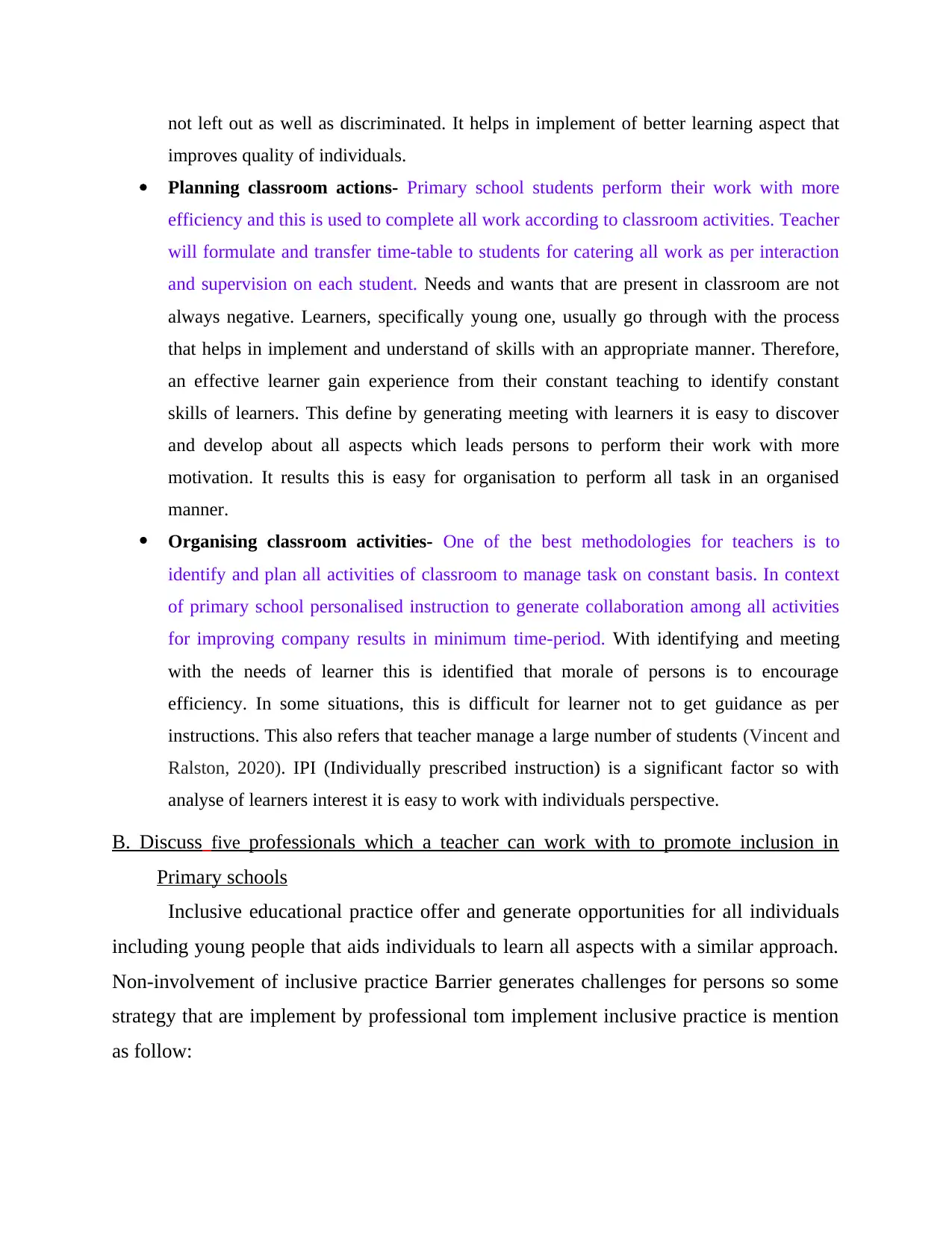
not left out as well as discriminated. It helps in implement of better learning aspect that
improves quality of individuals.
Planning classroom actions- Primary school students perform their work with more
efficiency and this is used to complete all work according to classroom activities. Teacher
will formulate and transfer time-table to students for catering all work as per interaction
and supervision on each student. Needs and wants that are present in classroom are not
always negative. Learners, specifically young one, usually go through with the process
that helps in implement and understand of skills with an appropriate manner. Therefore,
an effective learner gain experience from their constant teaching to identify constant
skills of learners. This define by generating meeting with learners it is easy to discover
and develop about all aspects which leads persons to perform their work with more
motivation. It results this is easy for organisation to perform all task in an organised
manner.
Organising classroom activities- One of the best methodologies for teachers is to
identify and plan all activities of classroom to manage task on constant basis. In context
of primary school personalised instruction to generate collaboration among all activities
for improving company results in minimum time-period. With identifying and meeting
with the needs of learner this is identified that morale of persons is to encourage
efficiency. In some situations, this is difficult for learner not to get guidance as per
instructions. This also refers that teacher manage a large number of students (Vincent and
Ralston, 2020). IPI (Individually prescribed instruction) is a significant factor so with
analyse of learners interest it is easy to work with individuals perspective.
B. Discuss five professionals which a teacher can work with to promote inclusion in
Primary schools
Inclusive educational practice offer and generate opportunities for all individuals
including young people that aids individuals to learn all aspects with a similar approach.
Non-involvement of inclusive practice Barrier generates challenges for persons so some
strategy that are implement by professional tom implement inclusive practice is mention
as follow:
improves quality of individuals.
Planning classroom actions- Primary school students perform their work with more
efficiency and this is used to complete all work according to classroom activities. Teacher
will formulate and transfer time-table to students for catering all work as per interaction
and supervision on each student. Needs and wants that are present in classroom are not
always negative. Learners, specifically young one, usually go through with the process
that helps in implement and understand of skills with an appropriate manner. Therefore,
an effective learner gain experience from their constant teaching to identify constant
skills of learners. This define by generating meeting with learners it is easy to discover
and develop about all aspects which leads persons to perform their work with more
motivation. It results this is easy for organisation to perform all task in an organised
manner.
Organising classroom activities- One of the best methodologies for teachers is to
identify and plan all activities of classroom to manage task on constant basis. In context
of primary school personalised instruction to generate collaboration among all activities
for improving company results in minimum time-period. With identifying and meeting
with the needs of learner this is identified that morale of persons is to encourage
efficiency. In some situations, this is difficult for learner not to get guidance as per
instructions. This also refers that teacher manage a large number of students (Vincent and
Ralston, 2020). IPI (Individually prescribed instruction) is a significant factor so with
analyse of learners interest it is easy to work with individuals perspective.
B. Discuss five professionals which a teacher can work with to promote inclusion in
Primary schools
Inclusive educational practice offer and generate opportunities for all individuals
including young people that aids individuals to learn all aspects with a similar approach.
Non-involvement of inclusive practice Barrier generates challenges for persons so some
strategy that are implement by professional tom implement inclusive practice is mention
as follow:
Secure Best Marks with AI Grader
Need help grading? Try our AI Grader for instant feedback on your assignments.
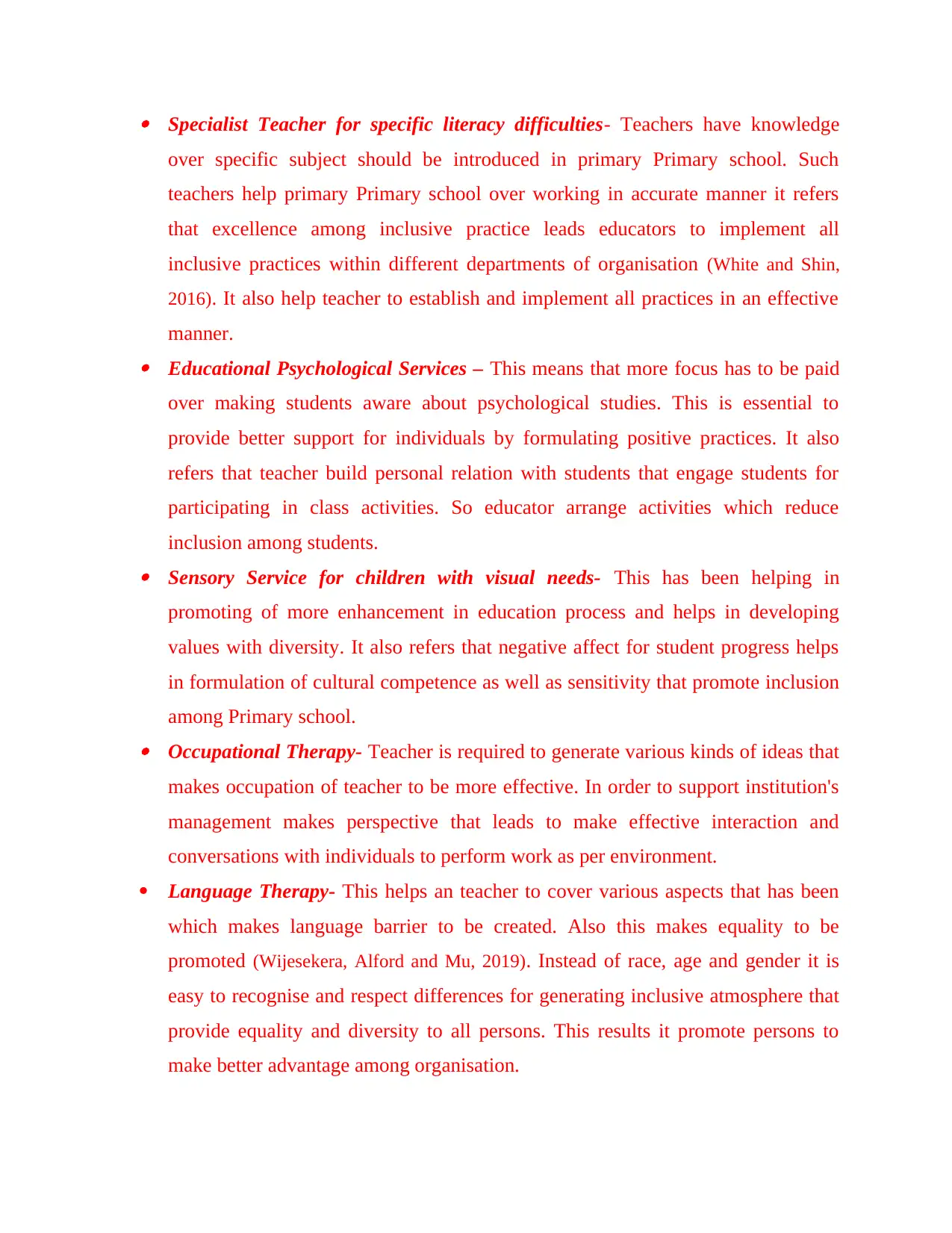
Specialist Teacher for specific literacy difficulties- Teachers have knowledge
over specific subject should be introduced in primary Primary school. Such
teachers help primary Primary school over working in accurate manner it refers
that excellence among inclusive practice leads educators to implement all
inclusive practices within different departments of organisation (White and Shin,
2016). It also help teacher to establish and implement all practices in an effective
manner. Educational Psychological Services – This means that more focus has to be paid
over making students aware about psychological studies. This is essential to
provide better support for individuals by formulating positive practices. It also
refers that teacher build personal relation with students that engage students for
participating in class activities. So educator arrange activities which reduce
inclusion among students. Sensory Service for children with visual needs- This has been helping in
promoting of more enhancement in education process and helps in developing
values with diversity. It also refers that negative affect for student progress helps
in formulation of cultural competence as well as sensitivity that promote inclusion
among Primary school. Occupational Therapy- Teacher is required to generate various kinds of ideas that
makes occupation of teacher to be more effective. In order to support institution's
management makes perspective that leads to make effective interaction and
conversations with individuals to perform work as per environment.
Language Therapy- This helps an teacher to cover various aspects that has been
which makes language barrier to be created. Also this makes equality to be
promoted (Wijesekera, Alford and Mu, 2019). Instead of race, age and gender it is
easy to recognise and respect differences for generating inclusive atmosphere that
provide equality and diversity to all persons. This results it promote persons to
make better advantage among organisation.
over specific subject should be introduced in primary Primary school. Such
teachers help primary Primary school over working in accurate manner it refers
that excellence among inclusive practice leads educators to implement all
inclusive practices within different departments of organisation (White and Shin,
2016). It also help teacher to establish and implement all practices in an effective
manner. Educational Psychological Services – This means that more focus has to be paid
over making students aware about psychological studies. This is essential to
provide better support for individuals by formulating positive practices. It also
refers that teacher build personal relation with students that engage students for
participating in class activities. So educator arrange activities which reduce
inclusion among students. Sensory Service for children with visual needs- This has been helping in
promoting of more enhancement in education process and helps in developing
values with diversity. It also refers that negative affect for student progress helps
in formulation of cultural competence as well as sensitivity that promote inclusion
among Primary school. Occupational Therapy- Teacher is required to generate various kinds of ideas that
makes occupation of teacher to be more effective. In order to support institution's
management makes perspective that leads to make effective interaction and
conversations with individuals to perform work as per environment.
Language Therapy- This helps an teacher to cover various aspects that has been
which makes language barrier to be created. Also this makes equality to be
promoted (Wijesekera, Alford and Mu, 2019). Instead of race, age and gender it is
easy to recognise and respect differences for generating inclusive atmosphere that
provide equality and diversity to all persons. This results it promote persons to
make better advantage among organisation.
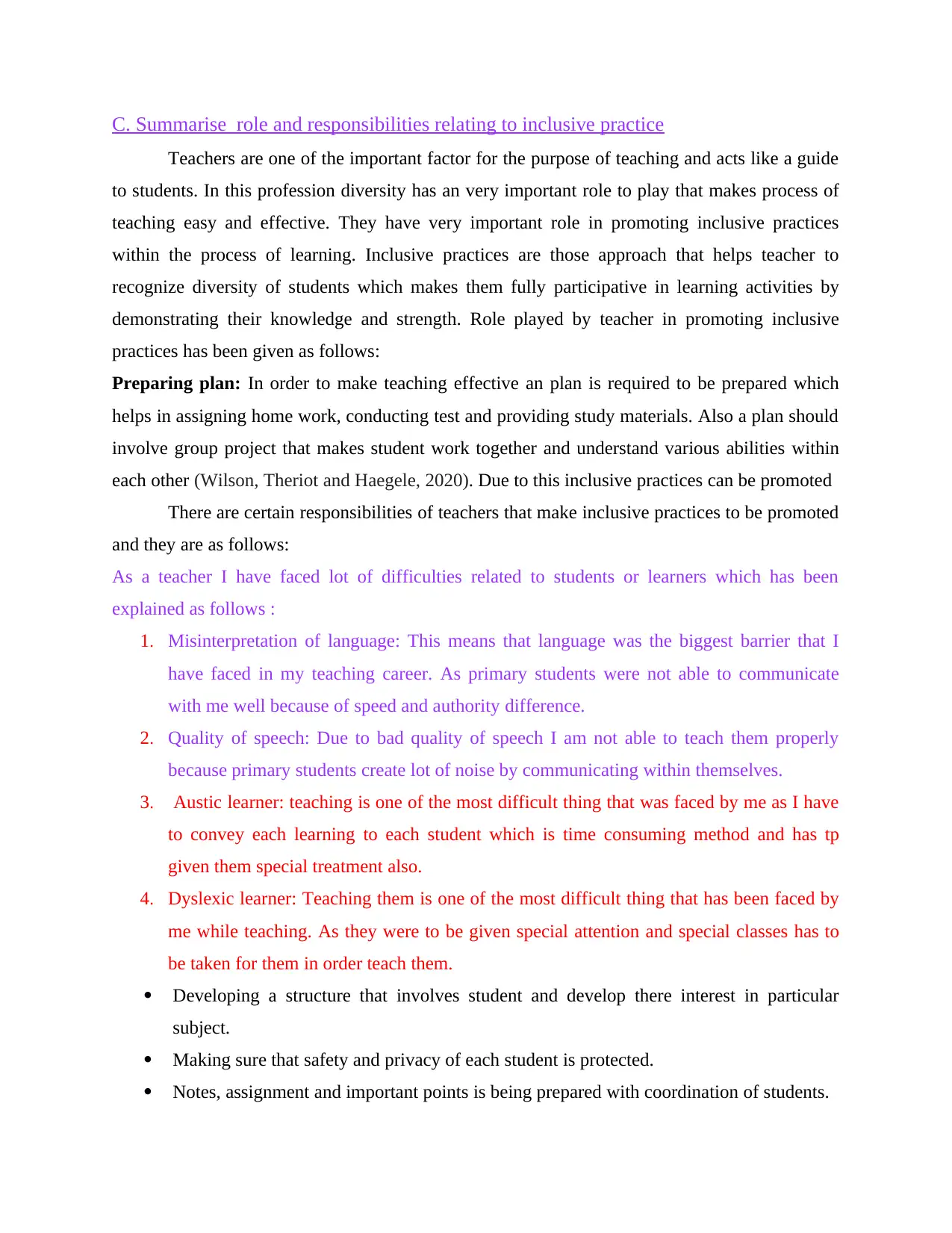
C. Summarise role and responsibilities relating to inclusive practice
Teachers are one of the important factor for the purpose of teaching and acts like a guide
to students. In this profession diversity has an very important role to play that makes process of
teaching easy and effective. They have very important role in promoting inclusive practices
within the process of learning. Inclusive practices are those approach that helps teacher to
recognize diversity of students which makes them fully participative in learning activities by
demonstrating their knowledge and strength. Role played by teacher in promoting inclusive
practices has been given as follows:
Preparing plan: In order to make teaching effective an plan is required to be prepared which
helps in assigning home work, conducting test and providing study materials. Also a plan should
involve group project that makes student work together and understand various abilities within
each other (Wilson, Theriot and Haegele, 2020). Due to this inclusive practices can be promoted
There are certain responsibilities of teachers that make inclusive practices to be promoted
and they are as follows:
As a teacher I have faced lot of difficulties related to students or learners which has been
explained as follows :
1. Misinterpretation of language: This means that language was the biggest barrier that I
have faced in my teaching career. As primary students were not able to communicate
with me well because of speed and authority difference.
2. Quality of speech: Due to bad quality of speech I am not able to teach them properly
because primary students create lot of noise by communicating within themselves.
3. Austic learner: teaching is one of the most difficult thing that was faced by me as I have
to convey each learning to each student which is time consuming method and has tp
given them special treatment also.
4. Dyslexic learner: Teaching them is one of the most difficult thing that has been faced by
me while teaching. As they were to be given special attention and special classes has to
be taken for them in order teach them.
Developing a structure that involves student and develop there interest in particular
subject.
Making sure that safety and privacy of each student is protected.
Notes, assignment and important points is being prepared with coordination of students.
Teachers are one of the important factor for the purpose of teaching and acts like a guide
to students. In this profession diversity has an very important role to play that makes process of
teaching easy and effective. They have very important role in promoting inclusive practices
within the process of learning. Inclusive practices are those approach that helps teacher to
recognize diversity of students which makes them fully participative in learning activities by
demonstrating their knowledge and strength. Role played by teacher in promoting inclusive
practices has been given as follows:
Preparing plan: In order to make teaching effective an plan is required to be prepared which
helps in assigning home work, conducting test and providing study materials. Also a plan should
involve group project that makes student work together and understand various abilities within
each other (Wilson, Theriot and Haegele, 2020). Due to this inclusive practices can be promoted
There are certain responsibilities of teachers that make inclusive practices to be promoted
and they are as follows:
As a teacher I have faced lot of difficulties related to students or learners which has been
explained as follows :
1. Misinterpretation of language: This means that language was the biggest barrier that I
have faced in my teaching career. As primary students were not able to communicate
with me well because of speed and authority difference.
2. Quality of speech: Due to bad quality of speech I am not able to teach them properly
because primary students create lot of noise by communicating within themselves.
3. Austic learner: teaching is one of the most difficult thing that was faced by me as I have
to convey each learning to each student which is time consuming method and has tp
given them special treatment also.
4. Dyslexic learner: Teaching them is one of the most difficult thing that has been faced by
me while teaching. As they were to be given special attention and special classes has to
be taken for them in order teach them.
Developing a structure that involves student and develop there interest in particular
subject.
Making sure that safety and privacy of each student is protected.
Notes, assignment and important points is being prepared with coordination of students.
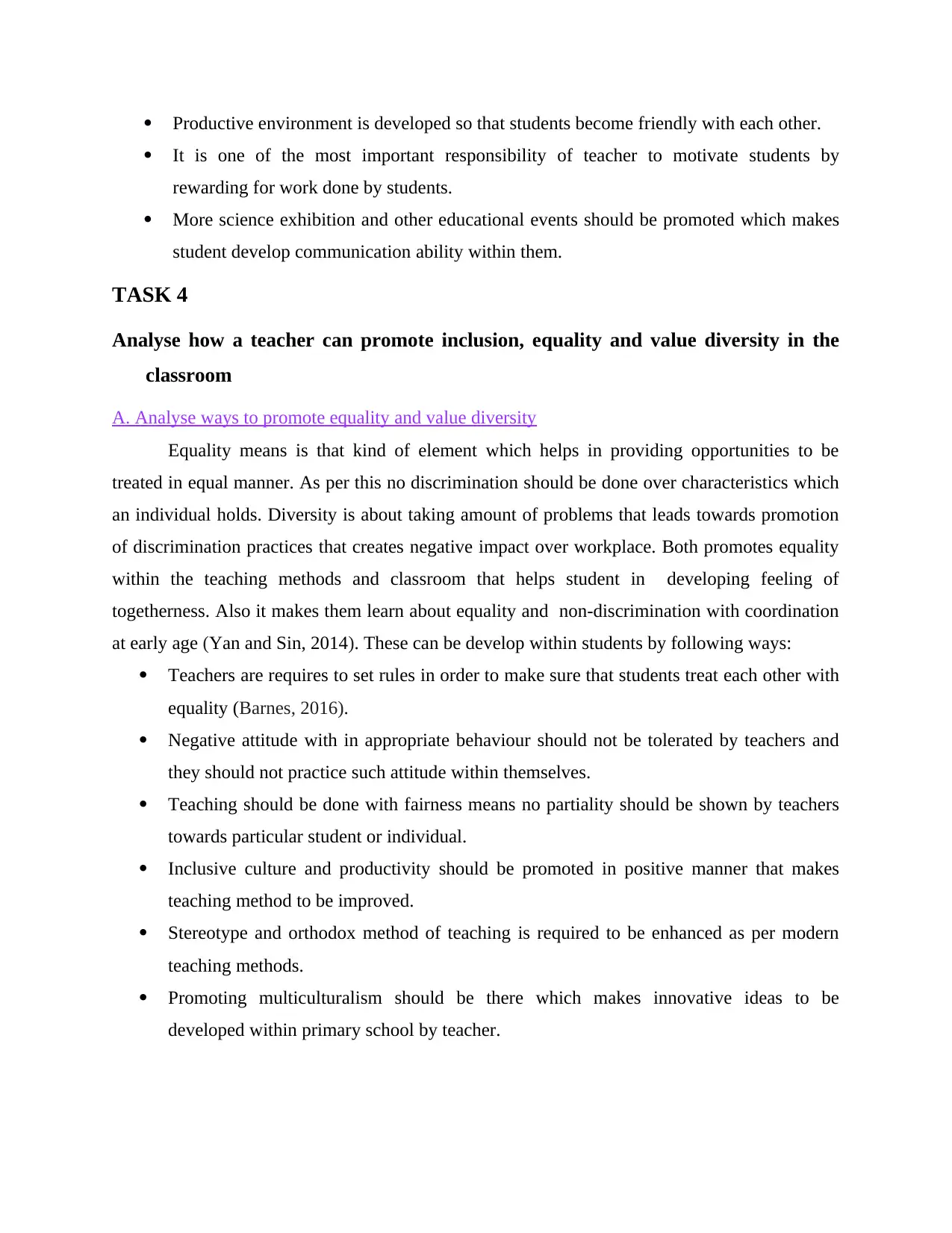
Productive environment is developed so that students become friendly with each other.
It is one of the most important responsibility of teacher to motivate students by
rewarding for work done by students.
More science exhibition and other educational events should be promoted which makes
student develop communication ability within them.
TASK 4
Analyse how a teacher can promote inclusion, equality and value diversity in the
classroom
A. Analyse ways to promote equality and value diversity
Equality means is that kind of element which helps in providing opportunities to be
treated in equal manner. As per this no discrimination should be done over characteristics which
an individual holds. Diversity is about taking amount of problems that leads towards promotion
of discrimination practices that creates negative impact over workplace. Both promotes equality
within the teaching methods and classroom that helps student in developing feeling of
togetherness. Also it makes them learn about equality and non-discrimination with coordination
at early age (Yan and Sin, 2014). These can be develop within students by following ways:
Teachers are requires to set rules in order to make sure that students treat each other with
equality (Barnes, 2016).
Negative attitude with in appropriate behaviour should not be tolerated by teachers and
they should not practice such attitude within themselves.
Teaching should be done with fairness means no partiality should be shown by teachers
towards particular student or individual.
Inclusive culture and productivity should be promoted in positive manner that makes
teaching method to be improved.
Stereotype and orthodox method of teaching is required to be enhanced as per modern
teaching methods.
Promoting multiculturalism should be there which makes innovative ideas to be
developed within primary school by teacher.
It is one of the most important responsibility of teacher to motivate students by
rewarding for work done by students.
More science exhibition and other educational events should be promoted which makes
student develop communication ability within them.
TASK 4
Analyse how a teacher can promote inclusion, equality and value diversity in the
classroom
A. Analyse ways to promote equality and value diversity
Equality means is that kind of element which helps in providing opportunities to be
treated in equal manner. As per this no discrimination should be done over characteristics which
an individual holds. Diversity is about taking amount of problems that leads towards promotion
of discrimination practices that creates negative impact over workplace. Both promotes equality
within the teaching methods and classroom that helps student in developing feeling of
togetherness. Also it makes them learn about equality and non-discrimination with coordination
at early age (Yan and Sin, 2014). These can be develop within students by following ways:
Teachers are requires to set rules in order to make sure that students treat each other with
equality (Barnes, 2016).
Negative attitude with in appropriate behaviour should not be tolerated by teachers and
they should not practice such attitude within themselves.
Teaching should be done with fairness means no partiality should be shown by teachers
towards particular student or individual.
Inclusive culture and productivity should be promoted in positive manner that makes
teaching method to be improved.
Stereotype and orthodox method of teaching is required to be enhanced as per modern
teaching methods.
Promoting multiculturalism should be there which makes innovative ideas to be
developed within primary school by teacher.
Paraphrase This Document
Need a fresh take? Get an instant paraphrase of this document with our AI Paraphraser
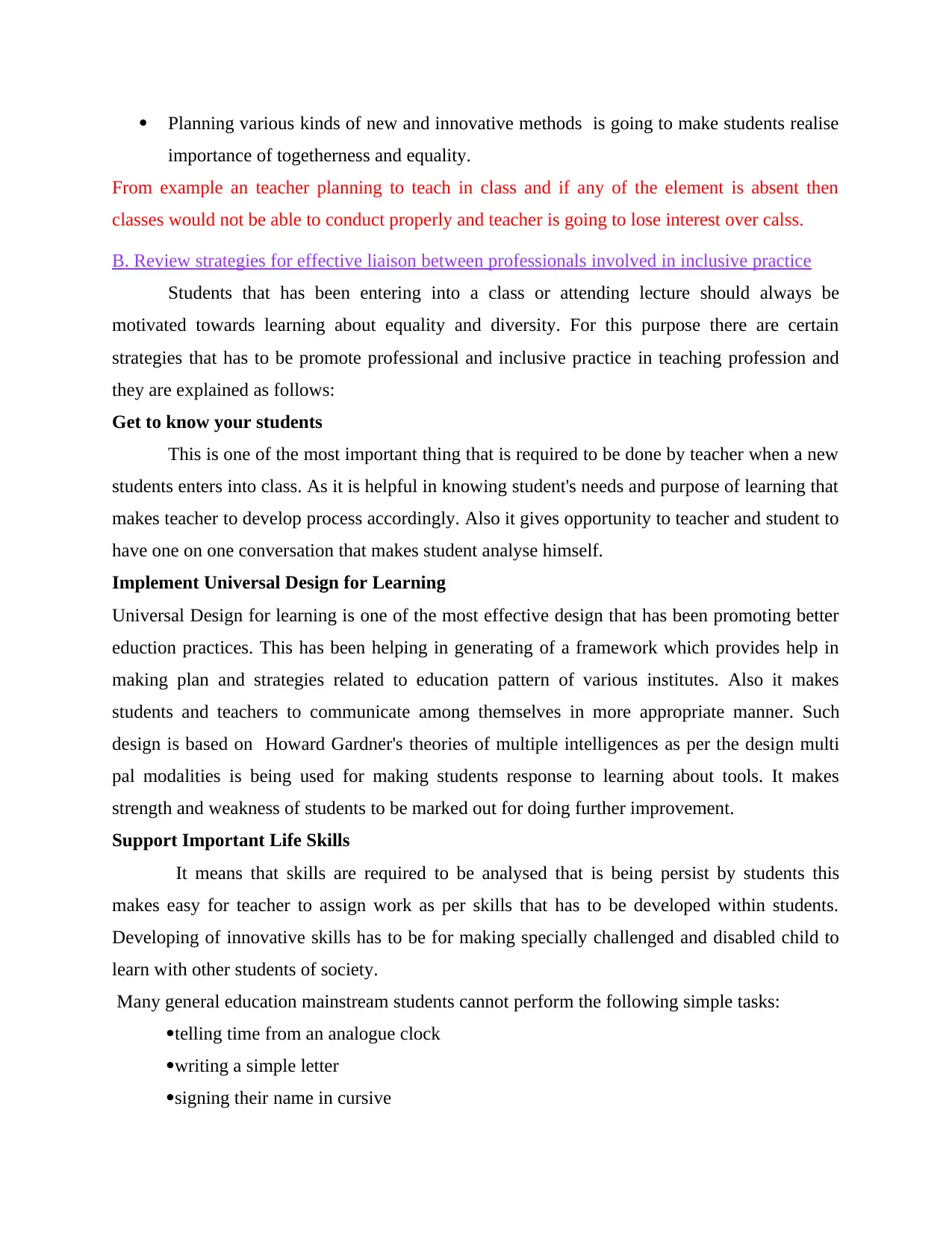
Planning various kinds of new and innovative methods is going to make students realise
importance of togetherness and equality.
From example an teacher planning to teach in class and if any of the element is absent then
classes would not be able to conduct properly and teacher is going to lose interest over calss.
B. Review strategies for effective liaison between professionals involved in inclusive practice
Students that has been entering into a class or attending lecture should always be
motivated towards learning about equality and diversity. For this purpose there are certain
strategies that has to be promote professional and inclusive practice in teaching profession and
they are explained as follows:
Get to know your students
This is one of the most important thing that is required to be done by teacher when a new
students enters into class. As it is helpful in knowing student's needs and purpose of learning that
makes teacher to develop process accordingly. Also it gives opportunity to teacher and student to
have one on one conversation that makes student analyse himself.
Implement Universal Design for Learning
Universal Design for learning is one of the most effective design that has been promoting better
eduction practices. This has been helping in generating of a framework which provides help in
making plan and strategies related to education pattern of various institutes. Also it makes
students and teachers to communicate among themselves in more appropriate manner. Such
design is based on Howard Gardner's theories of multiple intelligences as per the design multi
pal modalities is being used for making students response to learning about tools. It makes
strength and weakness of students to be marked out for doing further improvement.
Support Important Life Skills
It means that skills are required to be analysed that is being persist by students this
makes easy for teacher to assign work as per skills that has to be developed within students.
Developing of innovative skills has to be for making specially challenged and disabled child to
learn with other students of society.
Many general education mainstream students cannot perform the following simple tasks:
telling time from an analogue clock
writing a simple letter
signing their name in cursive
importance of togetherness and equality.
From example an teacher planning to teach in class and if any of the element is absent then
classes would not be able to conduct properly and teacher is going to lose interest over calss.
B. Review strategies for effective liaison between professionals involved in inclusive practice
Students that has been entering into a class or attending lecture should always be
motivated towards learning about equality and diversity. For this purpose there are certain
strategies that has to be promote professional and inclusive practice in teaching profession and
they are explained as follows:
Get to know your students
This is one of the most important thing that is required to be done by teacher when a new
students enters into class. As it is helpful in knowing student's needs and purpose of learning that
makes teacher to develop process accordingly. Also it gives opportunity to teacher and student to
have one on one conversation that makes student analyse himself.
Implement Universal Design for Learning
Universal Design for learning is one of the most effective design that has been promoting better
eduction practices. This has been helping in generating of a framework which provides help in
making plan and strategies related to education pattern of various institutes. Also it makes
students and teachers to communicate among themselves in more appropriate manner. Such
design is based on Howard Gardner's theories of multiple intelligences as per the design multi
pal modalities is being used for making students response to learning about tools. It makes
strength and weakness of students to be marked out for doing further improvement.
Support Important Life Skills
It means that skills are required to be analysed that is being persist by students this
makes easy for teacher to assign work as per skills that has to be developed within students.
Developing of innovative skills has to be for making specially challenged and disabled child to
learn with other students of society.
Many general education mainstream students cannot perform the following simple tasks:
telling time from an analogue clock
writing a simple letter
signing their name in cursive
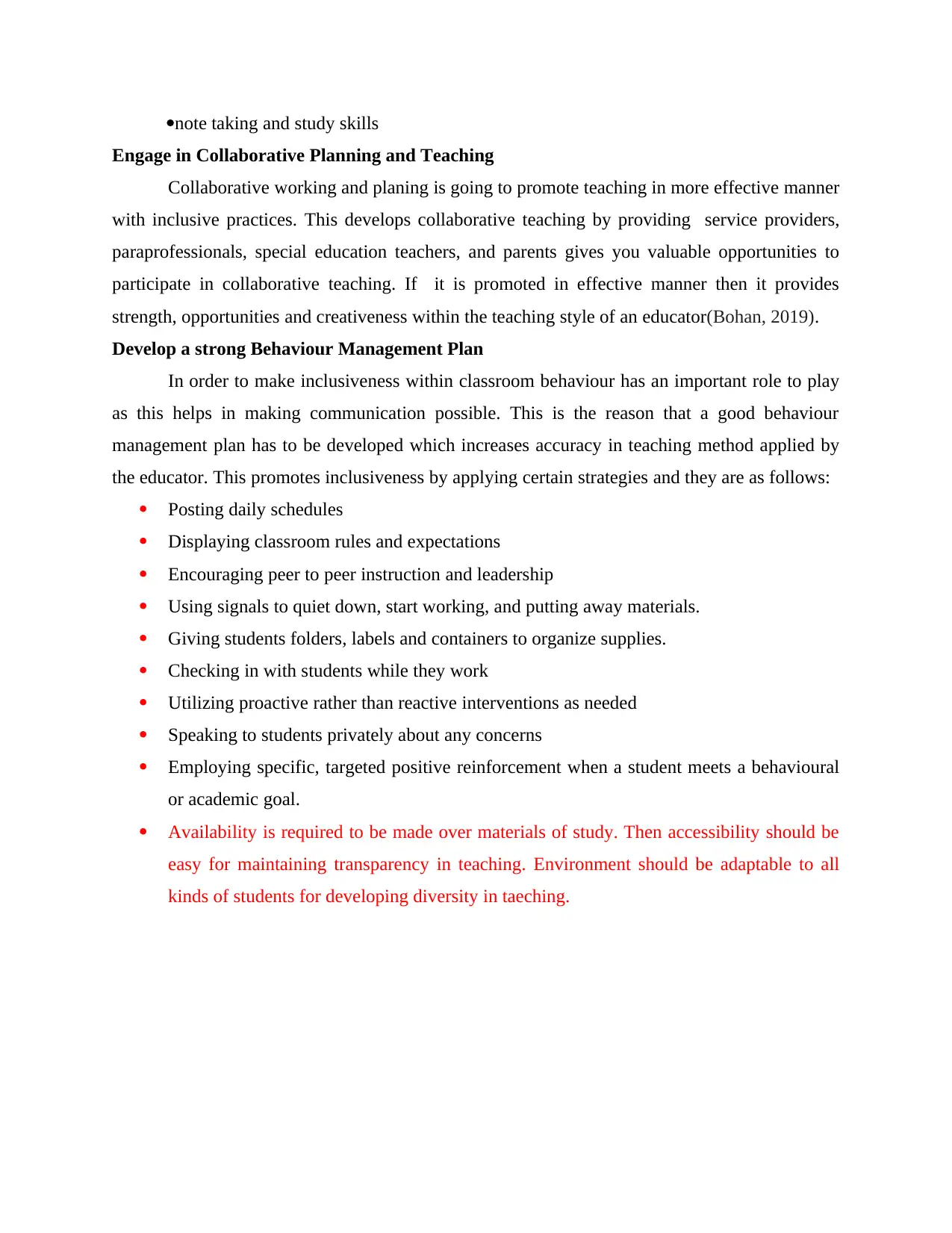
note taking and study skills
Engage in Collaborative Planning and Teaching
Collaborative working and planing is going to promote teaching in more effective manner
with inclusive practices. This develops collaborative teaching by providing service providers,
paraprofessionals, special education teachers, and parents gives you valuable opportunities to
participate in collaborative teaching. If it is promoted in effective manner then it provides
strength, opportunities and creativeness within the teaching style of an educator(Bohan, 2019).
Develop a strong Behaviour Management Plan
In order to make inclusiveness within classroom behaviour has an important role to play
as this helps in making communication possible. This is the reason that a good behaviour
management plan has to be developed which increases accuracy in teaching method applied by
the educator. This promotes inclusiveness by applying certain strategies and they are as follows:
Posting daily schedules
Displaying classroom rules and expectations
Encouraging peer to peer instruction and leadership
Using signals to quiet down, start working, and putting away materials.
Giving students folders, labels and containers to organize supplies.
Checking in with students while they work
Utilizing proactive rather than reactive interventions as needed
Speaking to students privately about any concerns
Employing specific, targeted positive reinforcement when a student meets a behavioural
or academic goal.
Availability is required to be made over materials of study. Then accessibility should be
easy for maintaining transparency in teaching. Environment should be adaptable to all
kinds of students for developing diversity in taeching.
Engage in Collaborative Planning and Teaching
Collaborative working and planing is going to promote teaching in more effective manner
with inclusive practices. This develops collaborative teaching by providing service providers,
paraprofessionals, special education teachers, and parents gives you valuable opportunities to
participate in collaborative teaching. If it is promoted in effective manner then it provides
strength, opportunities and creativeness within the teaching style of an educator(Bohan, 2019).
Develop a strong Behaviour Management Plan
In order to make inclusiveness within classroom behaviour has an important role to play
as this helps in making communication possible. This is the reason that a good behaviour
management plan has to be developed which increases accuracy in teaching method applied by
the educator. This promotes inclusiveness by applying certain strategies and they are as follows:
Posting daily schedules
Displaying classroom rules and expectations
Encouraging peer to peer instruction and leadership
Using signals to quiet down, start working, and putting away materials.
Giving students folders, labels and containers to organize supplies.
Checking in with students while they work
Utilizing proactive rather than reactive interventions as needed
Speaking to students privately about any concerns
Employing specific, targeted positive reinforcement when a student meets a behavioural
or academic goal.
Availability is required to be made over materials of study. Then accessibility should be
easy for maintaining transparency in teaching. Environment should be adaptable to all
kinds of students for developing diversity in taeching.
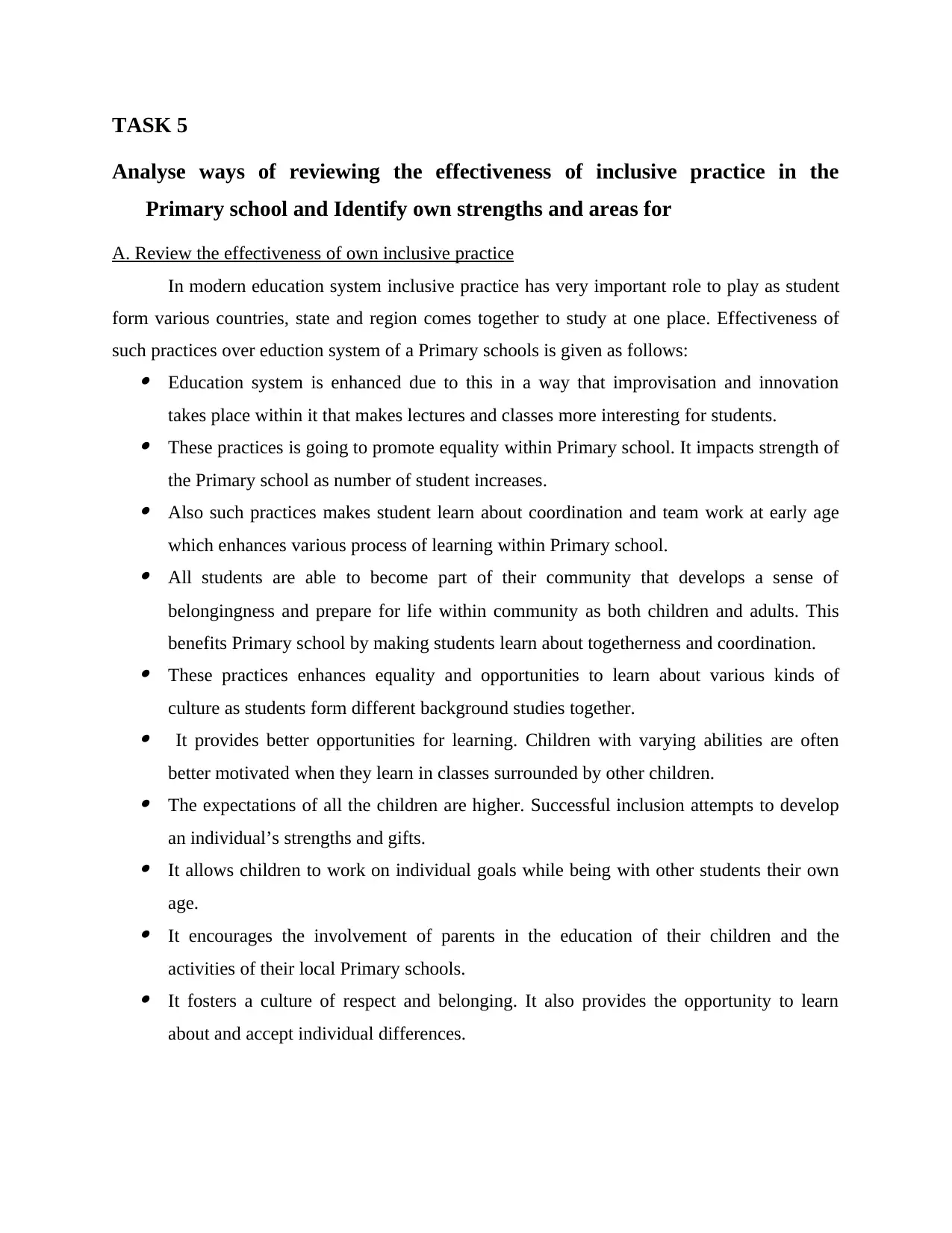
TASK 5
Analyse ways of reviewing the effectiveness of inclusive practice in the
Primary school and Identify own strengths and areas for
A. Review the effectiveness of own inclusive practice
In modern education system inclusive practice has very important role to play as student
form various countries, state and region comes together to study at one place. Effectiveness of
such practices over eduction system of a Primary schools is given as follows: Education system is enhanced due to this in a way that improvisation and innovation
takes place within it that makes lectures and classes more interesting for students. These practices is going to promote equality within Primary school. It impacts strength of
the Primary school as number of student increases. Also such practices makes student learn about coordination and team work at early age
which enhances various process of learning within Primary school. All students are able to become part of their community that develops a sense of
belongingness and prepare for life within community as both children and adults. This
benefits Primary school by making students learn about togetherness and coordination. These practices enhances equality and opportunities to learn about various kinds of
culture as students form different background studies together. It provides better opportunities for learning. Children with varying abilities are often
better motivated when they learn in classes surrounded by other children. The expectations of all the children are higher. Successful inclusion attempts to develop
an individual’s strengths and gifts. It allows children to work on individual goals while being with other students their own
age. It encourages the involvement of parents in the education of their children and the
activities of their local Primary schools. It fosters a culture of respect and belonging. It also provides the opportunity to learn
about and accept individual differences.
Analyse ways of reviewing the effectiveness of inclusive practice in the
Primary school and Identify own strengths and areas for
A. Review the effectiveness of own inclusive practice
In modern education system inclusive practice has very important role to play as student
form various countries, state and region comes together to study at one place. Effectiveness of
such practices over eduction system of a Primary schools is given as follows: Education system is enhanced due to this in a way that improvisation and innovation
takes place within it that makes lectures and classes more interesting for students. These practices is going to promote equality within Primary school. It impacts strength of
the Primary school as number of student increases. Also such practices makes student learn about coordination and team work at early age
which enhances various process of learning within Primary school. All students are able to become part of their community that develops a sense of
belongingness and prepare for life within community as both children and adults. This
benefits Primary school by making students learn about togetherness and coordination. These practices enhances equality and opportunities to learn about various kinds of
culture as students form different background studies together. It provides better opportunities for learning. Children with varying abilities are often
better motivated when they learn in classes surrounded by other children. The expectations of all the children are higher. Successful inclusion attempts to develop
an individual’s strengths and gifts. It allows children to work on individual goals while being with other students their own
age. It encourages the involvement of parents in the education of their children and the
activities of their local Primary schools. It fosters a culture of respect and belonging. It also provides the opportunity to learn
about and accept individual differences.
Secure Best Marks with AI Grader
Need help grading? Try our AI Grader for instant feedback on your assignments.
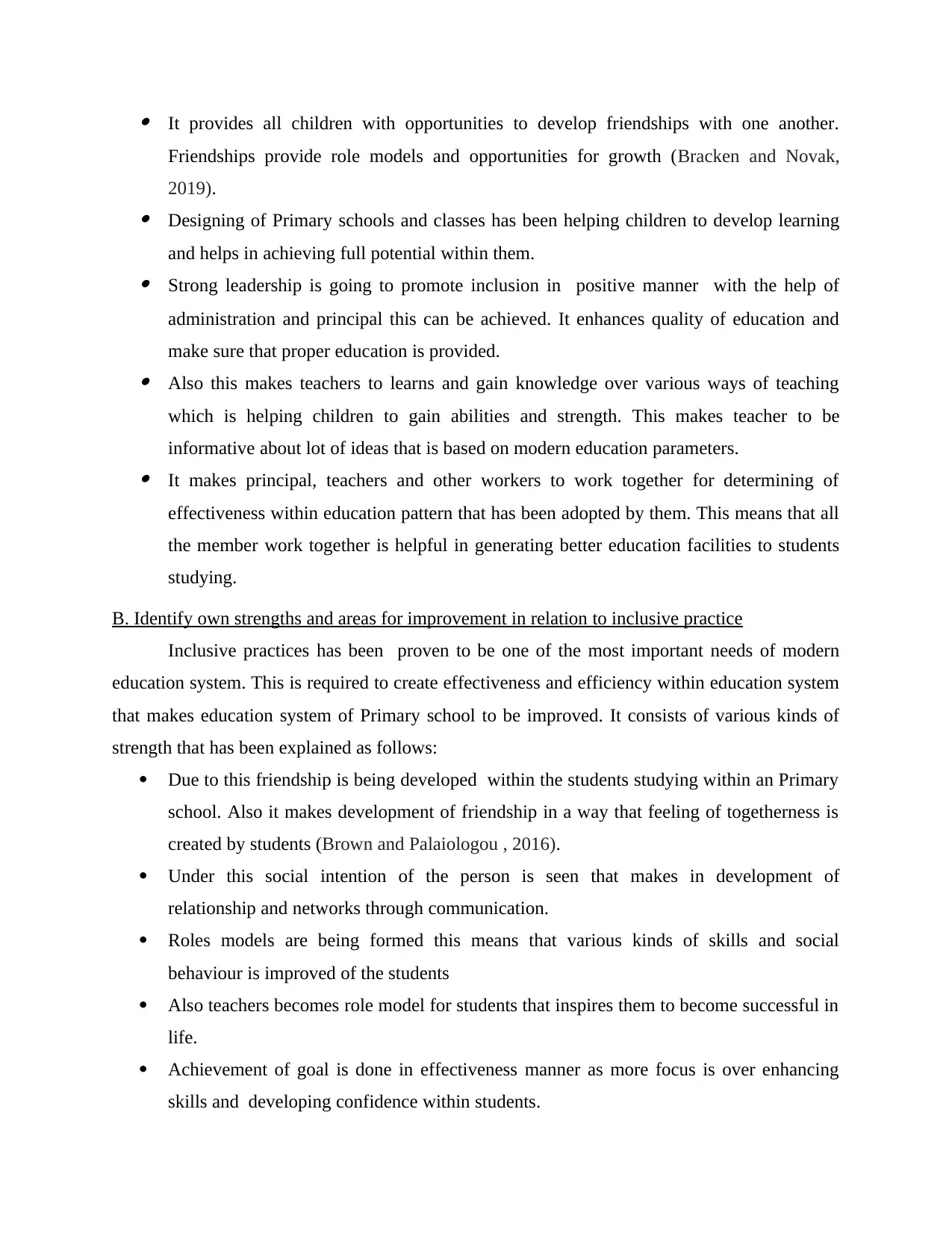
It provides all children with opportunities to develop friendships with one another.
Friendships provide role models and opportunities for growth (Bracken and Novak,
2019). Designing of Primary schools and classes has been helping children to develop learning
and helps in achieving full potential within them. Strong leadership is going to promote inclusion in positive manner with the help of
administration and principal this can be achieved. It enhances quality of education and
make sure that proper education is provided. Also this makes teachers to learns and gain knowledge over various ways of teaching
which is helping children to gain abilities and strength. This makes teacher to be
informative about lot of ideas that is based on modern education parameters. It makes principal, teachers and other workers to work together for determining of
effectiveness within education pattern that has been adopted by them. This means that all
the member work together is helpful in generating better education facilities to students
studying.
B. Identify own strengths and areas for improvement in relation to inclusive practice
Inclusive practices has been proven to be one of the most important needs of modern
education system. This is required to create effectiveness and efficiency within education system
that makes education system of Primary school to be improved. It consists of various kinds of
strength that has been explained as follows:
Due to this friendship is being developed within the students studying within an Primary
school. Also it makes development of friendship in a way that feeling of togetherness is
created by students (Brown and Palaiologou , 2016).
Under this social intention of the person is seen that makes in development of
relationship and networks through communication.
Roles models are being formed this means that various kinds of skills and social
behaviour is improved of the students
Also teachers becomes role model for students that inspires them to become successful in
life.
Achievement of goal is done in effectiveness manner as more focus is over enhancing
skills and developing confidence within students.
Friendships provide role models and opportunities for growth (Bracken and Novak,
2019). Designing of Primary schools and classes has been helping children to develop learning
and helps in achieving full potential within them. Strong leadership is going to promote inclusion in positive manner with the help of
administration and principal this can be achieved. It enhances quality of education and
make sure that proper education is provided. Also this makes teachers to learns and gain knowledge over various ways of teaching
which is helping children to gain abilities and strength. This makes teacher to be
informative about lot of ideas that is based on modern education parameters. It makes principal, teachers and other workers to work together for determining of
effectiveness within education pattern that has been adopted by them. This means that all
the member work together is helpful in generating better education facilities to students
studying.
B. Identify own strengths and areas for improvement in relation to inclusive practice
Inclusive practices has been proven to be one of the most important needs of modern
education system. This is required to create effectiveness and efficiency within education system
that makes education system of Primary school to be improved. It consists of various kinds of
strength that has been explained as follows:
Due to this friendship is being developed within the students studying within an Primary
school. Also it makes development of friendship in a way that feeling of togetherness is
created by students (Brown and Palaiologou , 2016).
Under this social intention of the person is seen that makes in development of
relationship and networks through communication.
Roles models are being formed this means that various kinds of skills and social
behaviour is improved of the students
Also teachers becomes role model for students that inspires them to become successful in
life.
Achievement of goal is done in effectiveness manner as more focus is over enhancing
skills and developing confidence within students.
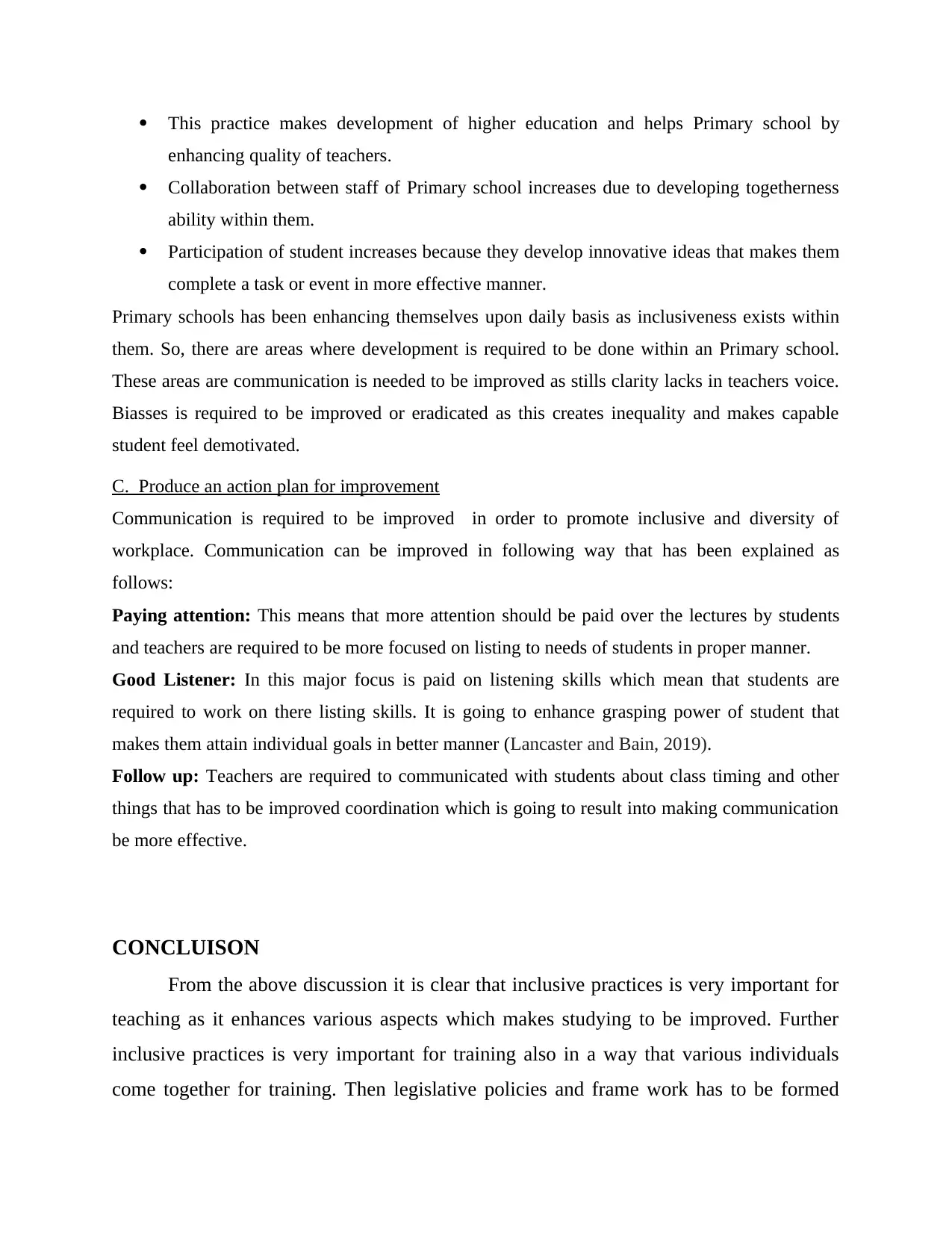
This practice makes development of higher education and helps Primary school by
enhancing quality of teachers.
Collaboration between staff of Primary school increases due to developing togetherness
ability within them.
Participation of student increases because they develop innovative ideas that makes them
complete a task or event in more effective manner.
Primary schools has been enhancing themselves upon daily basis as inclusiveness exists within
them. So, there are areas where development is required to be done within an Primary school.
These areas are communication is needed to be improved as stills clarity lacks in teachers voice.
Biasses is required to be improved or eradicated as this creates inequality and makes capable
student feel demotivated.
C. Produce an action plan for improvement
Communication is required to be improved in order to promote inclusive and diversity of
workplace. Communication can be improved in following way that has been explained as
follows:
Paying attention: This means that more attention should be paid over the lectures by students
and teachers are required to be more focused on listing to needs of students in proper manner.
Good Listener: In this major focus is paid on listening skills which mean that students are
required to work on there listing skills. It is going to enhance grasping power of student that
makes them attain individual goals in better manner (Lancaster and Bain, 2019).
Follow up: Teachers are required to communicated with students about class timing and other
things that has to be improved coordination which is going to result into making communication
be more effective.
CONCLUISON
From the above discussion it is clear that inclusive practices is very important for
teaching as it enhances various aspects which makes studying to be improved. Further
inclusive practices is very important for training also in a way that various individuals
come together for training. Then legislative policies and frame work has to be formed
enhancing quality of teachers.
Collaboration between staff of Primary school increases due to developing togetherness
ability within them.
Participation of student increases because they develop innovative ideas that makes them
complete a task or event in more effective manner.
Primary schools has been enhancing themselves upon daily basis as inclusiveness exists within
them. So, there are areas where development is required to be done within an Primary school.
These areas are communication is needed to be improved as stills clarity lacks in teachers voice.
Biasses is required to be improved or eradicated as this creates inequality and makes capable
student feel demotivated.
C. Produce an action plan for improvement
Communication is required to be improved in order to promote inclusive and diversity of
workplace. Communication can be improved in following way that has been explained as
follows:
Paying attention: This means that more attention should be paid over the lectures by students
and teachers are required to be more focused on listing to needs of students in proper manner.
Good Listener: In this major focus is paid on listening skills which mean that students are
required to work on there listing skills. It is going to enhance grasping power of student that
makes them attain individual goals in better manner (Lancaster and Bain, 2019).
Follow up: Teachers are required to communicated with students about class timing and other
things that has to be improved coordination which is going to result into making communication
be more effective.
CONCLUISON
From the above discussion it is clear that inclusive practices is very important for
teaching as it enhances various aspects which makes studying to be improved. Further
inclusive practices is very important for training also in a way that various individuals
come together for training. Then legislative policies and frame work has to be formed
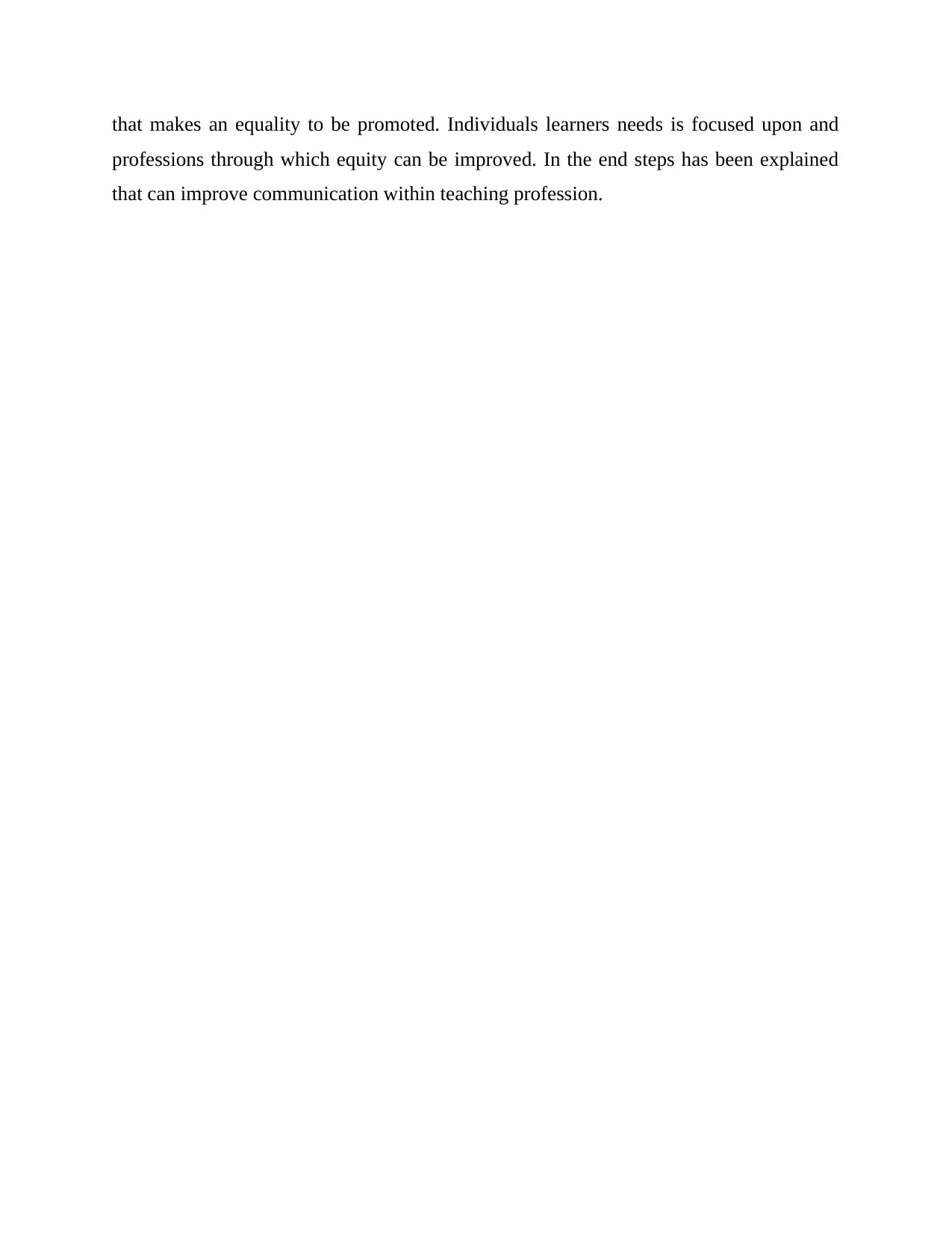
that makes an equality to be promoted. Individuals learners needs is focused upon and
professions through which equity can be improved. In the end steps has been explained
that can improve communication within teaching profession.
professions through which equity can be improved. In the end steps has been explained
that can improve communication within teaching profession.
Paraphrase This Document
Need a fresh take? Get an instant paraphrase of this document with our AI Paraphraser
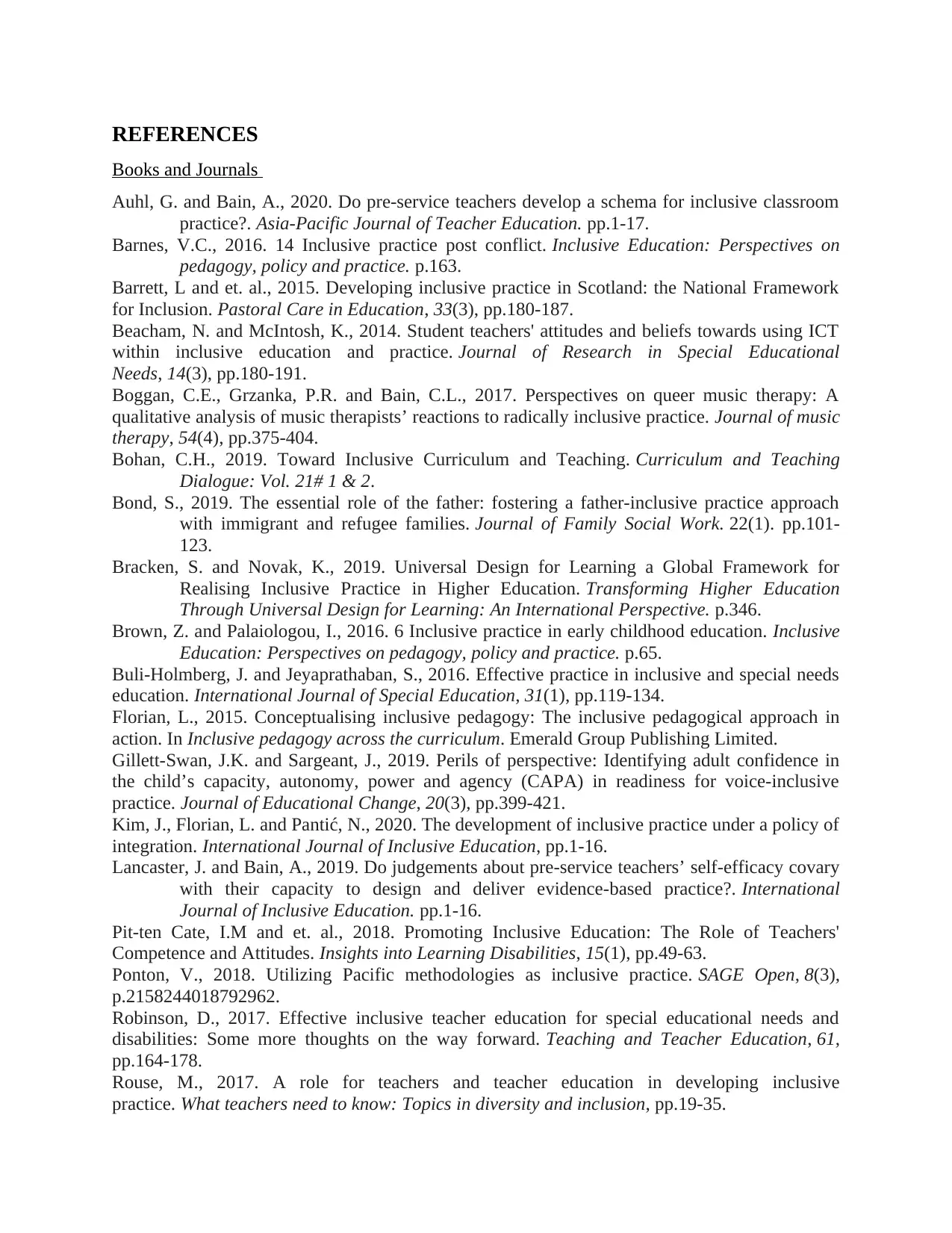
REFERENCES
Books and Journals
Auhl, G. and Bain, A., 2020. Do pre-service teachers develop a schema for inclusive classroom
practice?. Asia-Pacific Journal of Teacher Education. pp.1-17.
Barnes, V.C., 2016. 14 Inclusive practice post conflict. Inclusive Education: Perspectives on
pedagogy, policy and practice. p.163.
Barrett, L and et. al., 2015. Developing inclusive practice in Scotland: the National Framework
for Inclusion. Pastoral Care in Education, 33(3), pp.180-187.
Beacham, N. and McIntosh, K., 2014. Student teachers' attitudes and beliefs towards using ICT
within inclusive education and practice. Journal of Research in Special Educational
Needs, 14(3), pp.180-191.
Boggan, C.E., Grzanka, P.R. and Bain, C.L., 2017. Perspectives on queer music therapy: A
qualitative analysis of music therapists’ reactions to radically inclusive practice. Journal of music
therapy, 54(4), pp.375-404.
Bohan, C.H., 2019. Toward Inclusive Curriculum and Teaching. Curriculum and Teaching
Dialogue: Vol. 21# 1 & 2.
Bond, S., 2019. The essential role of the father: fostering a father-inclusive practice approach
with immigrant and refugee families. Journal of Family Social Work. 22(1). pp.101-
123.
Bracken, S. and Novak, K., 2019. Universal Design for Learning a Global Framework for
Realising Inclusive Practice in Higher Education. Transforming Higher Education
Through Universal Design for Learning: An International Perspective. p.346.
Brown, Z. and Palaiologou, I., 2016. 6 Inclusive practice in early childhood education. Inclusive
Education: Perspectives on pedagogy, policy and practice. p.65.
Buli-Holmberg, J. and Jeyaprathaban, S., 2016. Effective practice in inclusive and special needs
education. International Journal of Special Education, 31(1), pp.119-134.
Florian, L., 2015. Conceptualising inclusive pedagogy: The inclusive pedagogical approach in
action. In Inclusive pedagogy across the curriculum. Emerald Group Publishing Limited.
Gillett-Swan, J.K. and Sargeant, J., 2019. Perils of perspective: Identifying adult confidence in
the child’s capacity, autonomy, power and agency (CAPA) in readiness for voice-inclusive
practice. Journal of Educational Change, 20(3), pp.399-421.
Kim, J., Florian, L. and Pantić, N., 2020. The development of inclusive practice under a policy of
integration. International Journal of Inclusive Education, pp.1-16.
Lancaster, J. and Bain, A., 2019. Do judgements about pre-service teachers’ self-efficacy covary
with their capacity to design and deliver evidence-based practice?. International
Journal of Inclusive Education. pp.1-16.
Pit-ten Cate, I.M and et. al., 2018. Promoting Inclusive Education: The Role of Teachers'
Competence and Attitudes. Insights into Learning Disabilities, 15(1), pp.49-63.
Ponton, V., 2018. Utilizing Pacific methodologies as inclusive practice. SAGE Open, 8(3),
p.2158244018792962.
Robinson, D., 2017. Effective inclusive teacher education for special educational needs and
disabilities: Some more thoughts on the way forward. Teaching and Teacher Education, 61,
pp.164-178.
Rouse, M., 2017. A role for teachers and teacher education in developing inclusive
practice. What teachers need to know: Topics in diversity and inclusion, pp.19-35.
Books and Journals
Auhl, G. and Bain, A., 2020. Do pre-service teachers develop a schema for inclusive classroom
practice?. Asia-Pacific Journal of Teacher Education. pp.1-17.
Barnes, V.C., 2016. 14 Inclusive practice post conflict. Inclusive Education: Perspectives on
pedagogy, policy and practice. p.163.
Barrett, L and et. al., 2015. Developing inclusive practice in Scotland: the National Framework
for Inclusion. Pastoral Care in Education, 33(3), pp.180-187.
Beacham, N. and McIntosh, K., 2014. Student teachers' attitudes and beliefs towards using ICT
within inclusive education and practice. Journal of Research in Special Educational
Needs, 14(3), pp.180-191.
Boggan, C.E., Grzanka, P.R. and Bain, C.L., 2017. Perspectives on queer music therapy: A
qualitative analysis of music therapists’ reactions to radically inclusive practice. Journal of music
therapy, 54(4), pp.375-404.
Bohan, C.H., 2019. Toward Inclusive Curriculum and Teaching. Curriculum and Teaching
Dialogue: Vol. 21# 1 & 2.
Bond, S., 2019. The essential role of the father: fostering a father-inclusive practice approach
with immigrant and refugee families. Journal of Family Social Work. 22(1). pp.101-
123.
Bracken, S. and Novak, K., 2019. Universal Design for Learning a Global Framework for
Realising Inclusive Practice in Higher Education. Transforming Higher Education
Through Universal Design for Learning: An International Perspective. p.346.
Brown, Z. and Palaiologou, I., 2016. 6 Inclusive practice in early childhood education. Inclusive
Education: Perspectives on pedagogy, policy and practice. p.65.
Buli-Holmberg, J. and Jeyaprathaban, S., 2016. Effective practice in inclusive and special needs
education. International Journal of Special Education, 31(1), pp.119-134.
Florian, L., 2015. Conceptualising inclusive pedagogy: The inclusive pedagogical approach in
action. In Inclusive pedagogy across the curriculum. Emerald Group Publishing Limited.
Gillett-Swan, J.K. and Sargeant, J., 2019. Perils of perspective: Identifying adult confidence in
the child’s capacity, autonomy, power and agency (CAPA) in readiness for voice-inclusive
practice. Journal of Educational Change, 20(3), pp.399-421.
Kim, J., Florian, L. and Pantić, N., 2020. The development of inclusive practice under a policy of
integration. International Journal of Inclusive Education, pp.1-16.
Lancaster, J. and Bain, A., 2019. Do judgements about pre-service teachers’ self-efficacy covary
with their capacity to design and deliver evidence-based practice?. International
Journal of Inclusive Education. pp.1-16.
Pit-ten Cate, I.M and et. al., 2018. Promoting Inclusive Education: The Role of Teachers'
Competence and Attitudes. Insights into Learning Disabilities, 15(1), pp.49-63.
Ponton, V., 2018. Utilizing Pacific methodologies as inclusive practice. SAGE Open, 8(3),
p.2158244018792962.
Robinson, D., 2017. Effective inclusive teacher education for special educational needs and
disabilities: Some more thoughts on the way forward. Teaching and Teacher Education, 61,
pp.164-178.
Rouse, M., 2017. A role for teachers and teacher education in developing inclusive
practice. What teachers need to know: Topics in diversity and inclusion, pp.19-35.
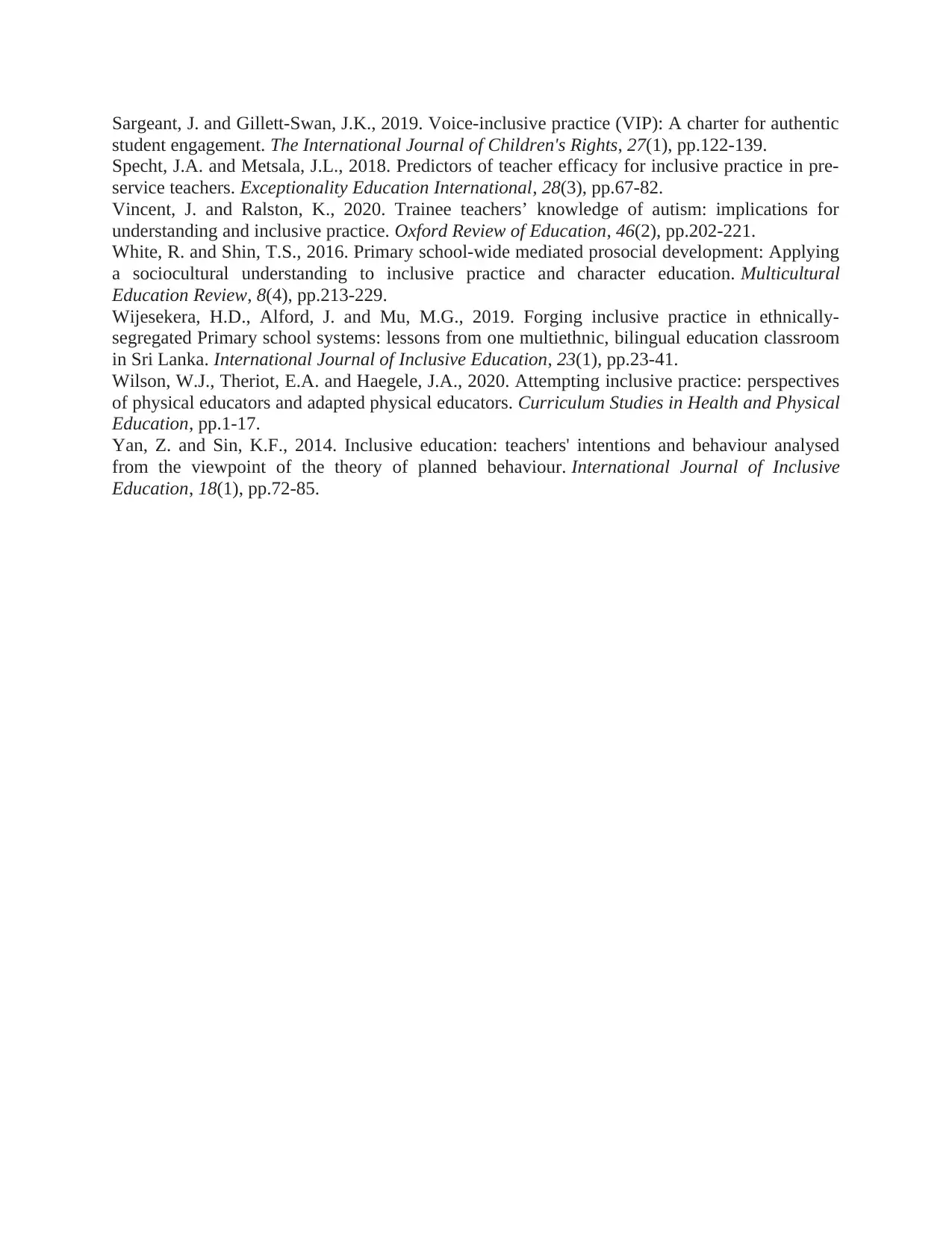
Sargeant, J. and Gillett-Swan, J.K., 2019. Voice-inclusive practice (VIP): A charter for authentic
student engagement. The International Journal of Children's Rights, 27(1), pp.122-139.
Specht, J.A. and Metsala, J.L., 2018. Predictors of teacher efficacy for inclusive practice in pre-
service teachers. Exceptionality Education International, 28(3), pp.67-82.
Vincent, J. and Ralston, K., 2020. Trainee teachers’ knowledge of autism: implications for
understanding and inclusive practice. Oxford Review of Education, 46(2), pp.202-221.
White, R. and Shin, T.S., 2016. Primary school-wide mediated prosocial development: Applying
a sociocultural understanding to inclusive practice and character education. Multicultural
Education Review, 8(4), pp.213-229.
Wijesekera, H.D., Alford, J. and Mu, M.G., 2019. Forging inclusive practice in ethnically-
segregated Primary school systems: lessons from one multiethnic, bilingual education classroom
in Sri Lanka. International Journal of Inclusive Education, 23(1), pp.23-41.
Wilson, W.J., Theriot, E.A. and Haegele, J.A., 2020. Attempting inclusive practice: perspectives
of physical educators and adapted physical educators. Curriculum Studies in Health and Physical
Education, pp.1-17.
Yan, Z. and Sin, K.F., 2014. Inclusive education: teachers' intentions and behaviour analysed
from the viewpoint of the theory of planned behaviour. International Journal of Inclusive
Education, 18(1), pp.72-85.
student engagement. The International Journal of Children's Rights, 27(1), pp.122-139.
Specht, J.A. and Metsala, J.L., 2018. Predictors of teacher efficacy for inclusive practice in pre-
service teachers. Exceptionality Education International, 28(3), pp.67-82.
Vincent, J. and Ralston, K., 2020. Trainee teachers’ knowledge of autism: implications for
understanding and inclusive practice. Oxford Review of Education, 46(2), pp.202-221.
White, R. and Shin, T.S., 2016. Primary school-wide mediated prosocial development: Applying
a sociocultural understanding to inclusive practice and character education. Multicultural
Education Review, 8(4), pp.213-229.
Wijesekera, H.D., Alford, J. and Mu, M.G., 2019. Forging inclusive practice in ethnically-
segregated Primary school systems: lessons from one multiethnic, bilingual education classroom
in Sri Lanka. International Journal of Inclusive Education, 23(1), pp.23-41.
Wilson, W.J., Theriot, E.A. and Haegele, J.A., 2020. Attempting inclusive practice: perspectives
of physical educators and adapted physical educators. Curriculum Studies in Health and Physical
Education, pp.1-17.
Yan, Z. and Sin, K.F., 2014. Inclusive education: teachers' intentions and behaviour analysed
from the viewpoint of the theory of planned behaviour. International Journal of Inclusive
Education, 18(1), pp.72-85.
1 out of 21
Related Documents
Your All-in-One AI-Powered Toolkit for Academic Success.
+13062052269
info@desklib.com
Available 24*7 on WhatsApp / Email
![[object Object]](/_next/static/media/star-bottom.7253800d.svg)
Unlock your academic potential
© 2024 | Zucol Services PVT LTD | All rights reserved.





